Annual Medvednica Clean-up Campaign to Take Place this Saturday
March 17, 2023 - Are you looking for ideas on how to spend your early spring weekend in Zagreb? Shopping malls and restaurants might seem like a waste of time for the lovely, sunny days ahead. Ideally, you would spend some time in nature, physically active and enjoying the fresh air. What better way to do that than some hiking, and what better location than Zagreb's own Medvednica? And with the clean-up campaign that is going to take place there, volunteers and associations are making sure that it's nicer, healthier, and more enjoyable for us all.
As 24Sata writes, the spring clean-up campaign on Medvednica will take place on Saturday from 9 am to 2 pm in several locations, and a large number of hikers and associations will participate, it was announced on Thursday at the Medvednica Nature Park Public Institution.
The campaign will take place in four locations - Talani, Vila Rebar, Zelena magistrala (Ramp for Sopot Waterfall, Ponikve), and Sveti Matej in the Park area in Krapina-Zagorje County.
"By removing and disposing of waste, we will contribute to raising awareness and a positive attitude towards our Park, as we have been doing continuously for many years. Together, we can contribute to a more beautiful and cleaner environment, to the preservation of biodiversity, and to greater satisfaction of all visitors to Medvednica", said the director of the institution, Marina Popijač.
This week, in cooperation with Croatian Forests (Hrvatske šume), several locations were cleaned to prepare them for more efficient waste removal, including Vejalnica, the area near Pustakova street, Gornje Vrapče, the entrance to the trail to Ferendol and Mali potok.
The Medvednica cleaning campaign takes place every spring in partnership with Croatian Forests, the Croatian Forest Society, the City of Zagreb, the company Čistoća, and the Municipality of Gornja Stubica.
For more, make sure to check out our dedicated News section.
How Far Can Zagreb Grič Cannon Fire? Ideal Conditions View of the Fire Range
July 21, 2021 - Ever wondered about the Zagreb Grič Cannon fire? TCN reporter Ivor Kruljac played with Google maps to provide an answer in ideal conditions.
While Zagreb Grič Cannon did not shoot at the time of writing this article, it is still one of the key symbols of Zagreb, and memories of its bang during midday is a vital part of the living in Zagreb experience.
As TCN previously wrote, the Grič Cannon was first introduced on January 1, 1877, and was located at the State's Meteorology department, back in the times when Croatia was part of the Austro-Hungarian Monarchy. It wasn't until 1927 that it was moved to Lotršćak, where it is situated to this day. In addition, the current cannon serving this purpose is actually the fifth to do the job and was donated to Zagreb by the Yugoslavian National Army (JNA), during Universiade.
Apart from signaling noon, the old legend says the Grič Cannon also served a defensive purpose. As TCN previously wrote, legend has it that the Ottoman commander Hasan Pasha (Hasan Paša) settled his army along the coast of the Sava river, in today's area of Novi Zagreb. He was preparing to cross the river and invade the city, but before that, he was about to have lunch, and Zagreb fired a cannon in the Ottomans' direction, close to Hasan, blasting a chicken he wanted to eat. The shot scared the hell out of the Ottomans, and they retreated, leaving Zagreb totally intact.
The legend itself is part of a book titled ''The Grič Cannon legend'' in which writer Dubravko Horvatić has gathered 20 Croatian legends, and the book is a mandatory book report title for Croatian pupils in the third year of elementary school.
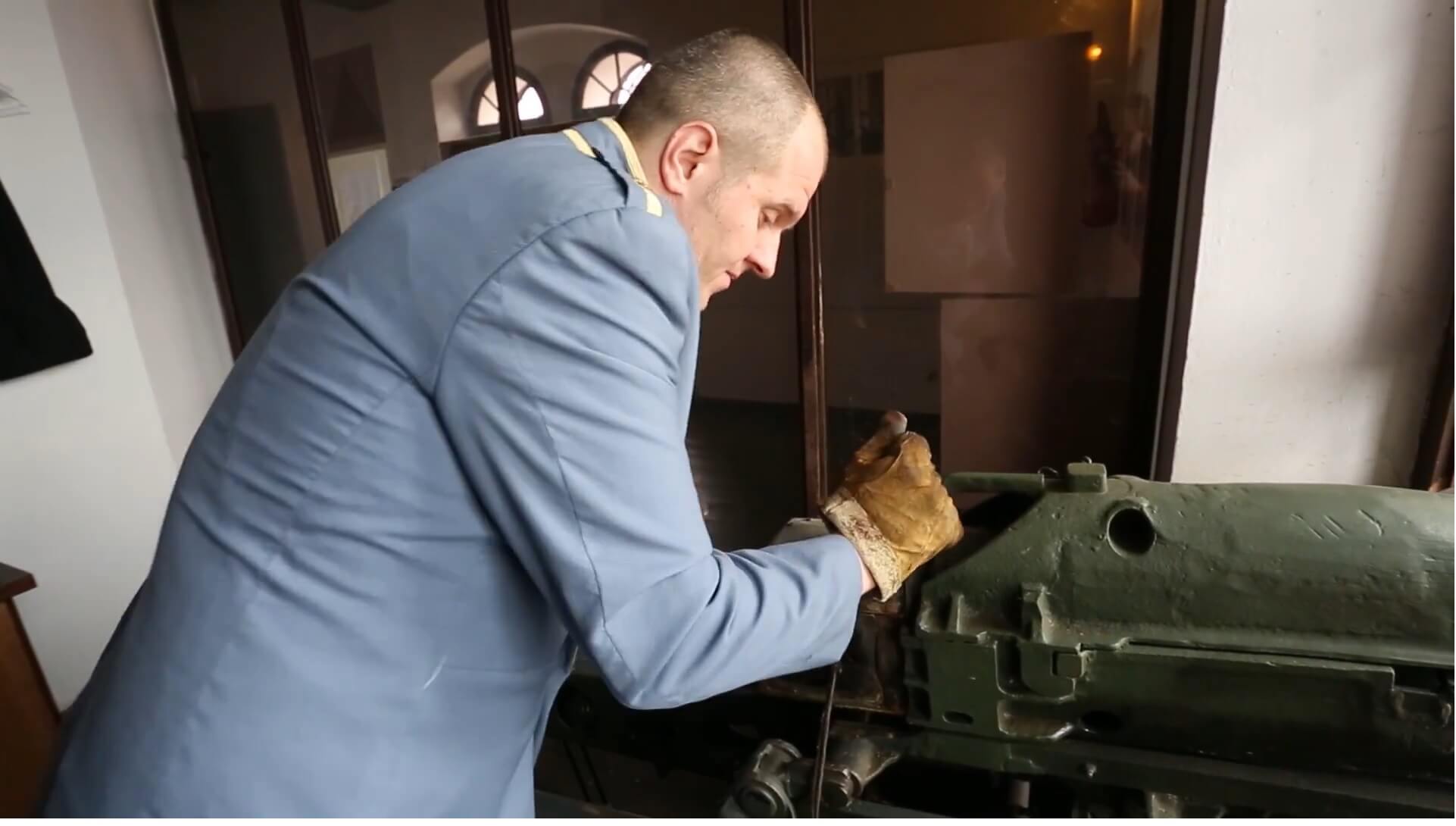 Preparing the cannon, screenshot / PIXSELL
Preparing the cannon, screenshot / PIXSELL
Legend vs facts
With the story taking place way back in the 16th century, it's obvious the tale is just a legend as the cannon wasn't introduced until the 19th century. Still, it's a cool story, and a bit of a twisted mind can't but help think: what's the range you could actually shoot with the Grič Cannon?
As the Wikipedia page says, and as a member of the Zagreb Tourist Board in Lotrščak tower confirmed to this sleuth reporter, the current cannon's range is 7,929 metres (almost eight kilometres), and the sound of the blast has a solid 140 dB.
Legend says Hasan Paša was on the coast of the Sava river, which means he was in southern Zagreb, and sure enough, the Grič cannon is facing south from Lotrščak. The cannon floor also has windows looking in each direction, meaning you could move the cannon to north, west, or east.
When playing with Google maps distance measuring tools, you can see that the smallest distance between the Sava river and Lotrščak is, give or take, about 3,1 kilometres. So, the current cannon, under the right angle, could easily make that shot.

The distance between Fort Lotrščak and Sava river, screenshot / Google Maps
Apart from the possibilities of buildings and hills messing up the shot, there are other things that need to be taken into consideration. As the Department of the Army U.S. Marine Corps identified back in 1996, in their manual, there are many factors that affect artillery fire.
Muzzle velocity, projectile weight, range wind, air temperature, air density, even the rotation of the Earth, not to mention the overall condition of the barrel, all of which are challenges that could limit the cannon's full potential. And yes, Google maps isn't really the most precise tool on the planet, but let's take a shot in the dark and see how far the Grič cannon could actually fire (keep in mind these projections are made solely based on the maximum range, and the factors aren't taken in account but are mentioned for the sake of trivia knowledge).
South! Aim! Fire!
Let's start from the cannon's current position. Assuming no buildings, hills, or anything else gets in the way, and you're a physics genius that managed to isolate yourself in Lotrščak with live ammo and achieve a clear straight shot, your cannonball makes an impact all the way in line with Donji Čehi (but a bit away to the east from that place). Donji Čehi, along with Gornji Čehi, used to be independent villages but are today part of the City of Zagreb. With only 1,72 km2 of length, the place is inhabited by 232 residents, based on a 2011 census.

Grič Cannon maximum range to the south, screenshot / Google Maps
West! Aim! Fire
Continue clockwise and set your cannon to take a shot towards the west, with a range of little under eight kilometres. You can score all the way to Krnska street in Gajnice. Krn is both a name of a mountain and a peak (2244) in neighbouring Slovenia. The mountain is a part of the Triglav National Park in Slovenia (and if this side note makes your attention turn to Slovenia, be sure to check our friends at Total Slovenia News). Gajnice is a neighbourhood in Zagreb that is inhabited by around 10,000 residents. The neighbourhood is notorious for its pretty lousy connection with the rest of the Zagreb, and local residents often complain about infrequent buses that connect them to Črnomerec from where they can travel to the city centre. Well, at least, the centre doesn't aim at them with a cannon.

Grič Cannon maximum range to the west, screenshot / Google Maps
North! Aim! Fire!
The new target, or perhaps better to say lucky shot, lies towards the north. Don't worry about Medvednica mountain getting in the way of a clear shot towards Zagorje, as the range isn't long enough. The shot will hit Medvednica mountain, more precisely, to the close proximity of Tusti Vrh. This location is 648 metres above sea level and serves as a stand for a communication station with some antenna polls. But, there's no need to shoot the place up and destroy a lovely piece of nature, which also serves as an important social role in regards to telecommunication. Instead, you can visit the place as the Gračani trail leads there.

Grič Cannon maximum range to the north, screenshot / Google Maps
East! Aim! Fire!
Finally, it's time to ruin someone's day in east Zagreb (fortunately, no person was hurt during these simulations in reality). Specifically, this applies to whoever lives in Retkovec III near Bruma Interijeri d.o.o., a company specialised in woodwork.
Petkovic is a neighbourhood that is part of the Dubrava district. It's mostly a residential place, like much of eastern neighbourhoods considered to be a bit of a rough area to live in. Still, things aren't as bad as they were as before.

Grič Cannon maximum range to the east, screenshot / Google Maps
Shooting blanks
Again, it's worth noting these projections aren't accurate science and imply conditions which are perfect. Of course, in an ideal world we wouldn't need firearms and everyone would be living in peace. In reality, where these ideal conditions don't apply, residents of the aforementioned areas, but also citizens in general, can be relaxed, as the ranges are irrelevant.
 Shots fired aftermath, screenshot / PIXSELL
Shots fired aftermath, screenshot / PIXSELL
''It's worth noting the cannon is modified, and it can't fire live ammo,'' warned the Zagreb TB official, who was a bit puzzled as to why I would even ask her for the potential range of a weapon overlooking the Croatian capital from Fort Lotrščak. But, as I'm sure any researcher will confirm, scientific curiosity often calls for asking controversial questions.
Learn more about Zagreb on our TC page.
For more about history in Croatia, follow TCN's dedicated page.
Bliznec Forest Trail Example of Best Practice in UNWTO's Accessible Tourism Book
ZAGREB, 30 May, 2021 - The UNWTO's recent publication entitled "Accessibility and Inclusive Tourism Development in Nature Areas - Compendium of Best Practices" cites the Bliznec Forest Trail in Medvednica Nature Park as an example of accessible tourism in nature areas, the Croatian National Tourist Board (HTZ) has reported.
This forest trail near the capital city of Zagreb is the first educational trail in Croatia fully adapted to people with disabilities.
The HTZ director Kristjan Staničić has recently stated that for more than a year the HTZ, in cooperation with the UNWTO and its Working Group on Accessible Tourism, has been working on the project of inclusive and accessible tourism.
"We are proud that Croatia has been added to this important publication about the best practices in inclusive and accessible tourism in nature areas," Staničić said.
The 800-metre-long Bliznec trail, along the Bliznec stream in Medvednica, is completely adjusted to visitors with disabilities.
"Apart from being completely available to people in wheelchairs, and therefore families with small children, all texts are available in Braille so that the blind and the people with poor eyesight can read them. To prevent them from being damaged, the texts in Braille are placed in unique 'Forest books'. The trail is primarily made of wood and it blends nicely with its surrounding. It finishes near the sawmill Bliznec where there is now a catering facility," according to the information provided on on the Medvednica Nature Park's website.
For more on travel in Croatia, follow TCN's dedicated page.
For more news about Croatia, CLICK HERE.
Tramlines Blocked Over 60 Year Unresolved City of Zagreb Land Dispute
February 14, 2021 – A resident of suburbs to the north of the Croatian capital today blocked the city's tramlines with a fence in protest over an unresolved City of Zagreb land dispute. He threatened to repeat the action over forthcoming days
Marijan Kos and his neighbours are seemingly sick of waiting. The City of Zagreb land dispute they and their families have been involved in has been dragging on for sixty years. Many have watched their neighbours die awaiting a resolution.
They are residents of the north Zagreb suburb of Gračani, just before Mount Medvednica and almost the northernmost point to where city trams travel. And they claim ownership of land over which the trams now pass. Nobody disputes their claim. But, following the compulsory confiscation of their property for passage of the tramway network, they have still not been reimbursed. So, this morning, Marijan Kos took matters into his own hands.
Carrying a prepared fence, another man and Mr Kos - who is president of the neighbourhood's local committee - stood on either side of the tram line to block an approaching tram. They waited for only 30 seconds before backing down, then allowed the driver and his passengers to continue on their way. The Zagreb land dispute protest was symbolic. This time.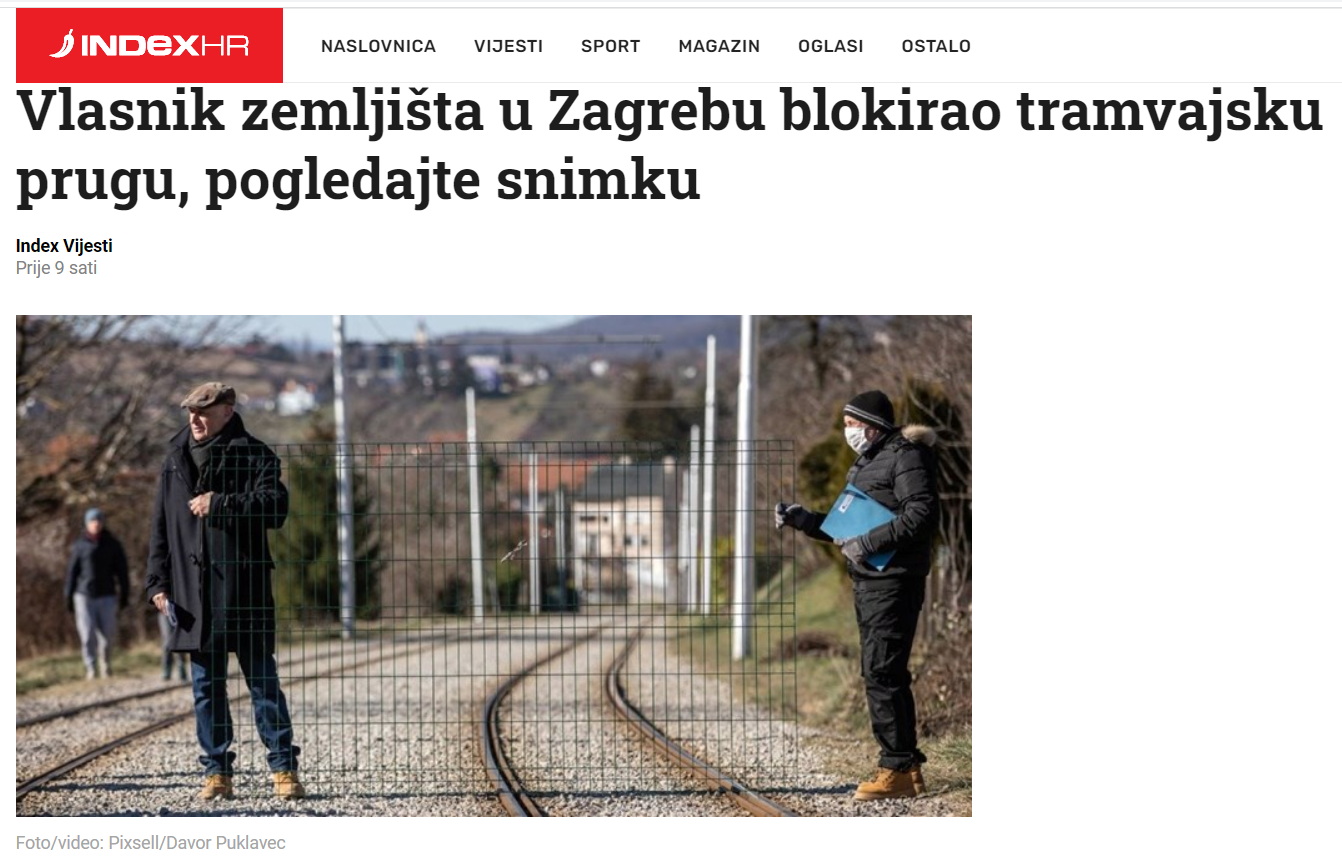 How Croatian portal Index carried the story of today's Zagreb land protest on the tramlines © Index screenshot
How Croatian portal Index carried the story of today's Zagreb land protest on the tramlines © Index screenshot
"With today's action we want to warn the City of Zagreb of the property-legal problem that has not been resolved since 1959,” Mr. Kos told reporters who had gathered to witness the Zagreb land dispute protest. “Since that year, we've had a final decision by which ZET (the tram network operator) is obliged to compensate the inhabitants of Gračani for the land confiscated for the construction of the tram line from Mihaljevac to Gracanski Dolj. That's about 166 land registry entries (and) there are about the same number of owners - some have already died and had no heirs. We are talking about 68,926 square meters of land on both sides of the tram line.”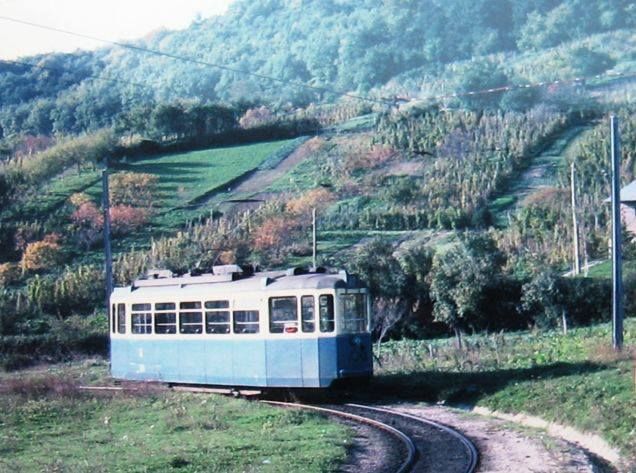 The tramline has run through the disputed land in Gracani for well over 50 years © Zagreb Facts
The tramline has run through the disputed land in Gracani for well over 50 years © Zagreb Facts
Mr. Kos invited the City to talk and uphold the standing agreement because, he says, it is in everyone's interest to resolve the matter in the best possible way. According to Vecernji List, who had a reporter at the scene, Mr. Kos reminded everyone that this tramline - once the mountain cable car opens - will become one of the main means of transport for all Zagreb residents and tourists to reach the top of Mount Medvednica.
Signalling that the Zagreb land dispute may escalate over forthcoming days, Mr. Kos went on to say; “We have prepared a fence and in the next few days we plan to install it and close the passage of trams if the City of Zagreb does not invite us to a meeting to try to solve this problem that has been dragging on for 50 years.”
Snow Queen Zagreb Begins Today, World's Best Skiers on Sljeme from Noon
January 3, 2021 - The world's best female skiers will open the Snow Queen Trophy on Sljeme on Sunday. Among them are two Croatian representatives.
Namely, HRT reports that Leona Popović will start 45th, and 16-year-old Zrinka Ljutić will have the starting number 65. Austrian skier Chiara Mair will open the race. The introductory program starts at noon on HRT 2.
With the sun's early rays, the ski staff and competitors arrived at the top of Medvednica on Saturday to better prepare for the competitive challenge that awaits female skiers on Sunday and male skiers on Wednesday. While winning and achieving good results is a priority, Croatian skiers find it hard to shake off the tragic 6.4 magnitude earthquake that struck central Croatia on December 29.
"It is an emergency with these earthquakes. Today is a day of mourning. I wish everyone all the best to really recover from that as soon as possible, it is not easy, and this year everything will definitely be a little different," said Samuel Kolega on Saturday.
Croatian skiers have grown used to skiing without the support of the fans who were especially loud on Sljeme. This season's World Cup debutant, Zrinka Ljutić, will find it challenging even without that kind of pressure, considering that she is just breaking the ice among the ski elite.
"We just had the last training here on the green slope. It's good, I feel good, I'm ready, I'll see how it will be tomorrow because of the snow. I hope the track will last until my ride, and I will do my best. I train a lot, I really work hard and I try hard, so we will see," said the young Croatian skier.
For this great effort to ultimately pay off with top results, Zrinka must gradually take on the world of skiing. The Ljutić team is aware of that, and Zrinka shared her goals for this season:
"I would like to enter the 30s in slalom and giant slalom, and have the best possible result at the Eurocup, which I will start during the season."
The Snow Queen Trophy organizers announced on their Facebook page that they would be donating to earthquake victims:
"Motivated by the recent catastrophic earthquake that hit Petrinja, Sisak, Glina, and the surrounding area, we decided to donate 10% of the prize money for the first 30 skiers to those affected. This donation will be matched by CroSki, bringing the total amount donated to 350.000 HRK. The funds will support people whose homes have been damaged or destroyed in central Croatia. Our hearts are with you."
To read more about sport in Croatia, follow TCN's dedicated page.
PHOTOS Autumn Day on Sljeme, Zagreb's Favourite Excursion Site
November 8, 2020 – Although Zagreb has been shrouded in fog on Sunday morning, it has been a sunny autumn day on Sljeme and its forest.
Standing 1000 meters above Zagreb, the highest peak of Mount Medvednica, Sljeme, is the perfect and most favourite weekend excursion site for many Zagreb residents, as well as people from the surrounding area.
Although the fog did not look promising on Sunday morning, many Zagreb recreationists and excursionists still decided to head to the highest peak of Zagreb. And they did not regret it, as the sun appeared just after the first hills. Climbing to an increasing elevation, the fog slowly but surely disappeared, and the late autumn sun shone through the already half-bare branches of the Medvednica forest.
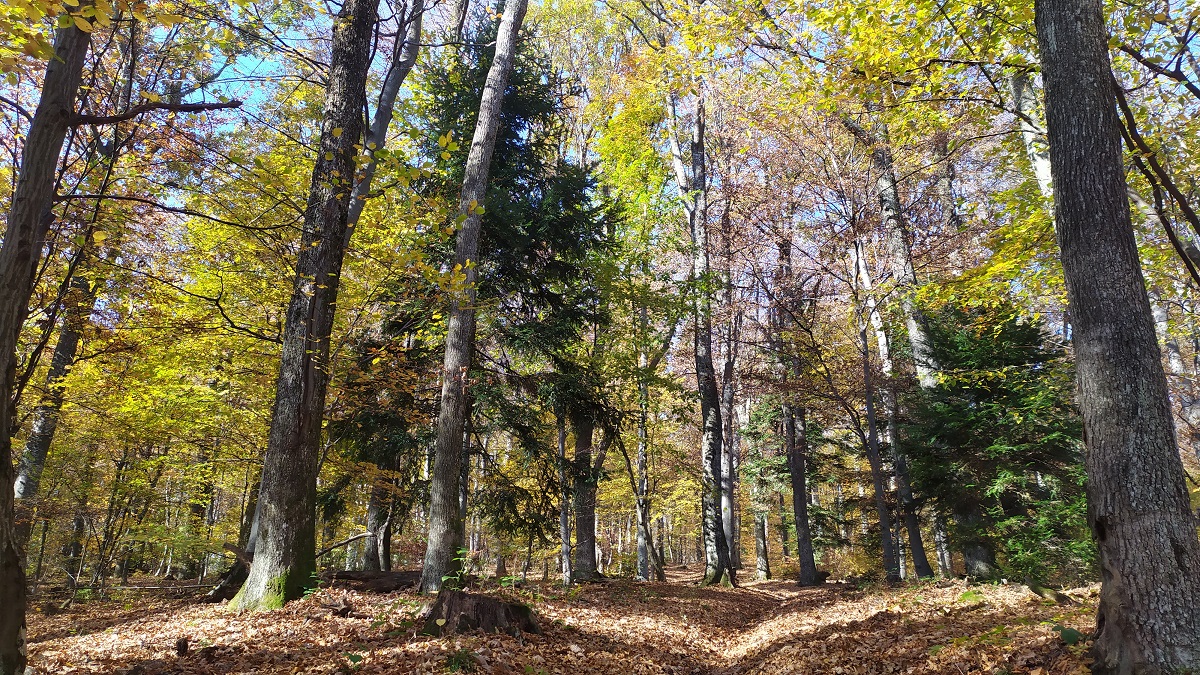
Sljeme (1033m), the highest peak of Medvednica or Zagrebačka Gora, as it is also called, can be reached on foot and by bike on hiking trails, or by road. From 1963 to 2007, the Sljeme cable car was in operation, and a new one is currently under construction, and should have its first test run of only 16 minutes very soon.
The area of Medvednica is also a nature park of the same name, and along the walk or ride through the beautiful forest, it is possible to get to know more than 1000 plant species. You can find your peace on as many as 70 hiking trails, and listen to the murmur of water from 70 streams. Exactly because of that, but also because of the immediate vicinity of the Croatian metropolis, the interest in visiting Medvednica and Sljeme is great throughout the whole year, and mostly on weekends.
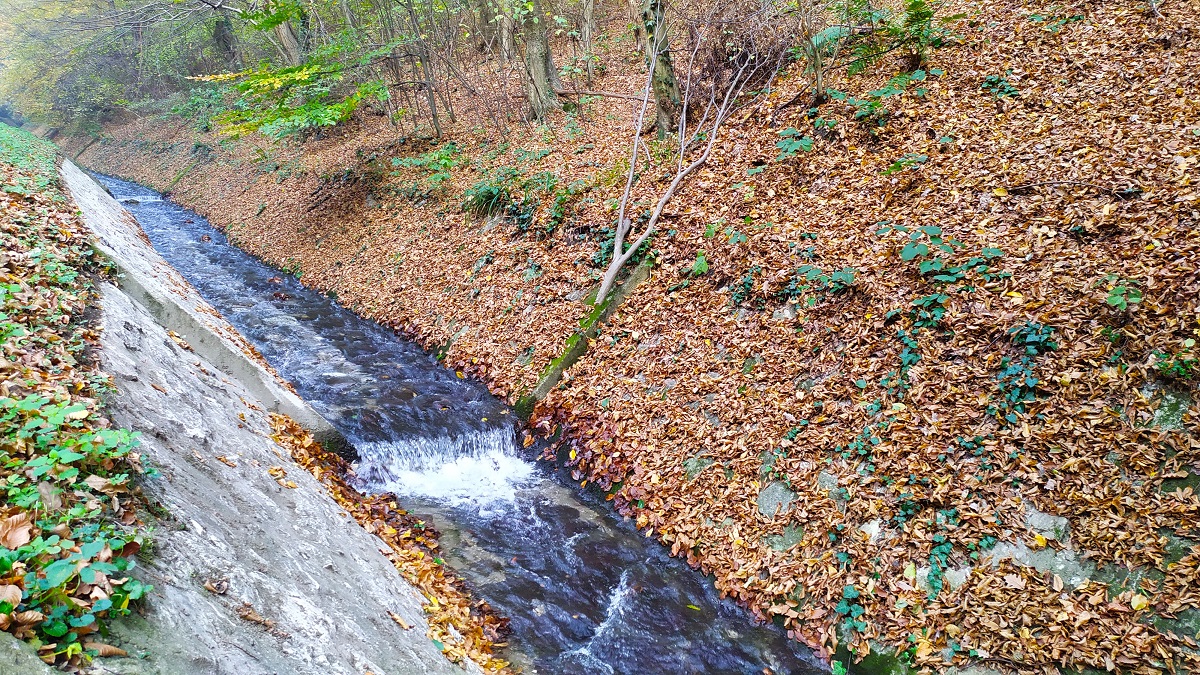
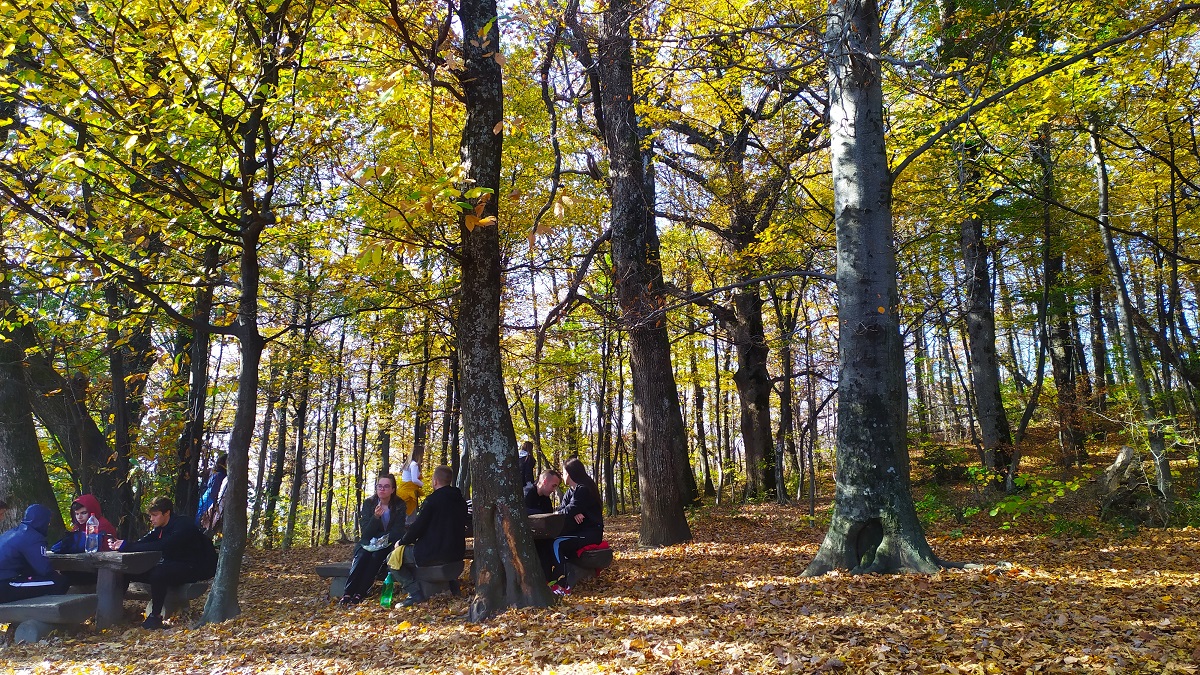
Apart from the beautiful untouched nature, there are other tourist attractions in the Medvednica Nature Park, such as the old medieval fortress Medvedgrad. The Veternica Cave, the sixth-largest in Croatia, and the Zrinski Mine, cultural heritage of the Republic of Croatia, are also an indispensable part of a visit to the park.
Since 2005, Sljeme has been the host of the Snow Queen Trophy ("Snježna kraljica"), women's slalom race of the World Ski Cup. The original name of the race was the Golden Bear ("Zlatni medvjed"), but it was changed in honor of Janica Kostelić, legendary Croatian skier, without whose sporting success the race would not have been given to Croatia and Zagreb to organize. Apart from that, Sljeme is also well-known for its television tower, visible from every part of Zagreb, and the Restaurant Vidikovac.

After a few hours of climbing, depending on the chosen route, hikers most look forward to eating homemade beans or baked “štrukli” and sweeten with strudels in the famous Mountain Lodge Puntijarka (947m).
The descent, due to fallen brown leaves and swept stones, is as challenging as the ascent to Sljeme, but the pleasure of observing the stems and treetops is even greater.
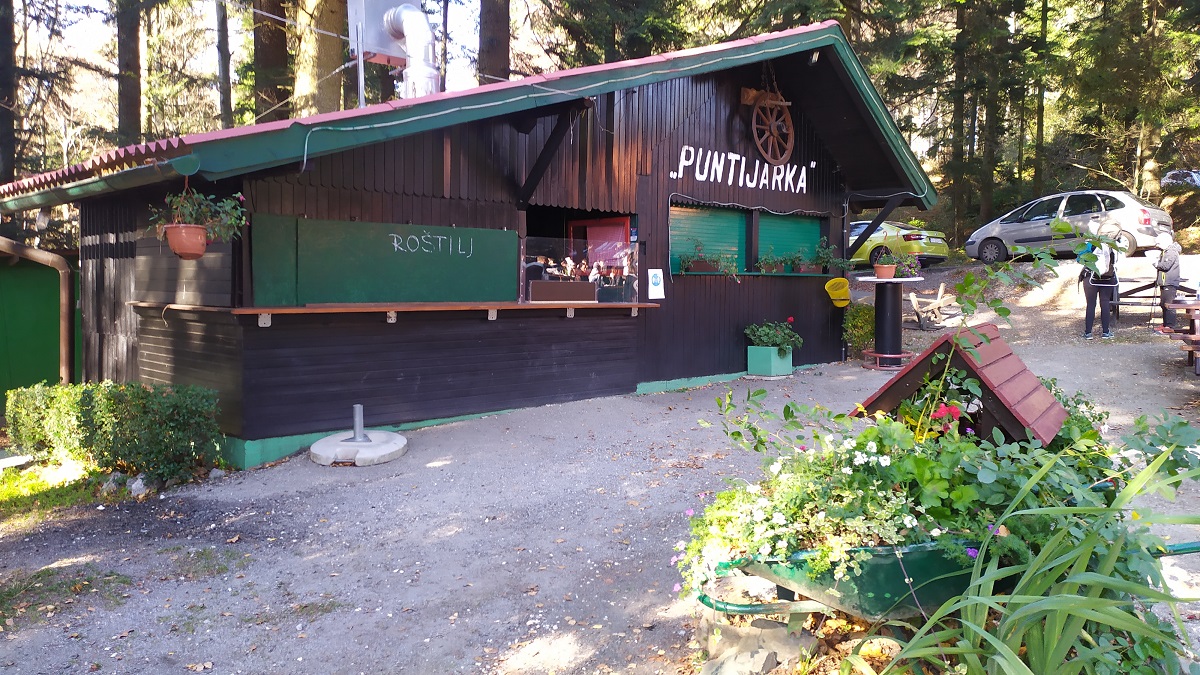
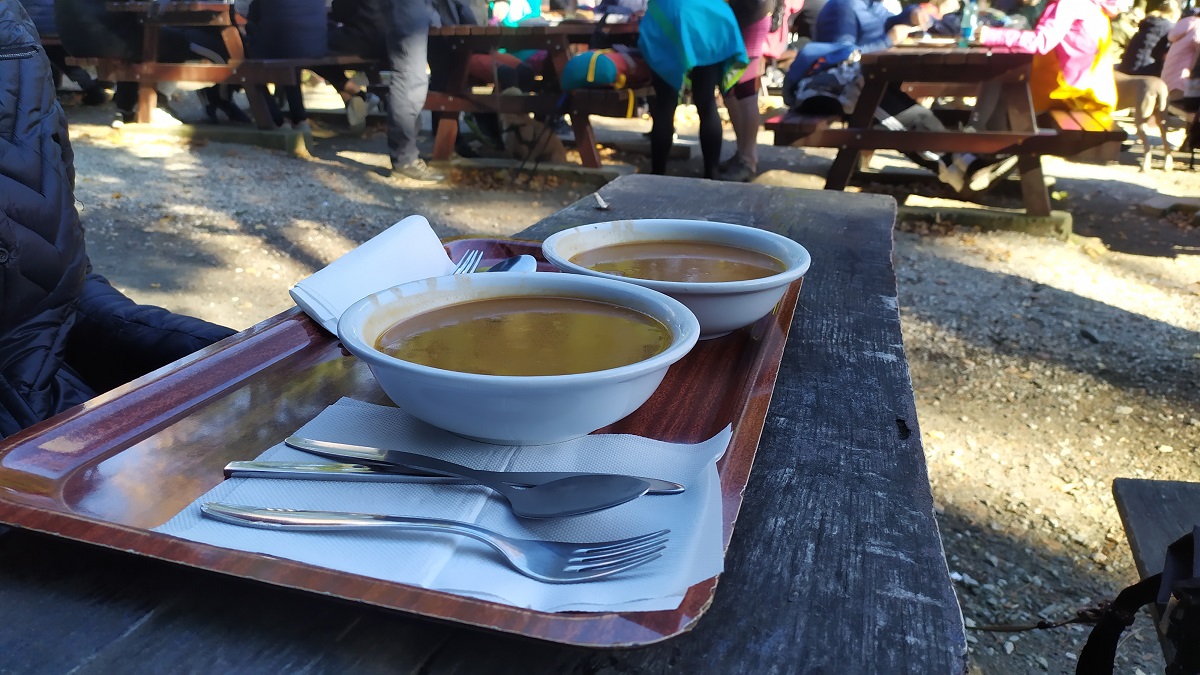
All photos © Donatella Pauković
For the latest travel info, bookmark our main travel info article, which is updated daily.
Read the Croatian Travel Update in your language - now available in 24 languages
Meet Zagreb Volunteers, the Heart and Soul of the City
October 29, 2020 - TCN joins Zagreb Volunteers Centre in Čučerje to find out who are the Zagreb volunteers and why they do what they do. Čučerje is a semi-rural community which lies at the epicentre of the March 2020 earthquake.
By the time we ran out of the building, the first tremor had stopped. At 6:25am, the asphalt road lay quiet and motionless. People in pyjamas, nightgowns or underwear stood on the pavement. Others emerged even later. Although masonry in other parts of the city continued to fall, the 5.5 magnitude earthquake that visited Zagreb on 22 March 2020 was over. It had lasted much less than a minute. Its repercussions would last much longer.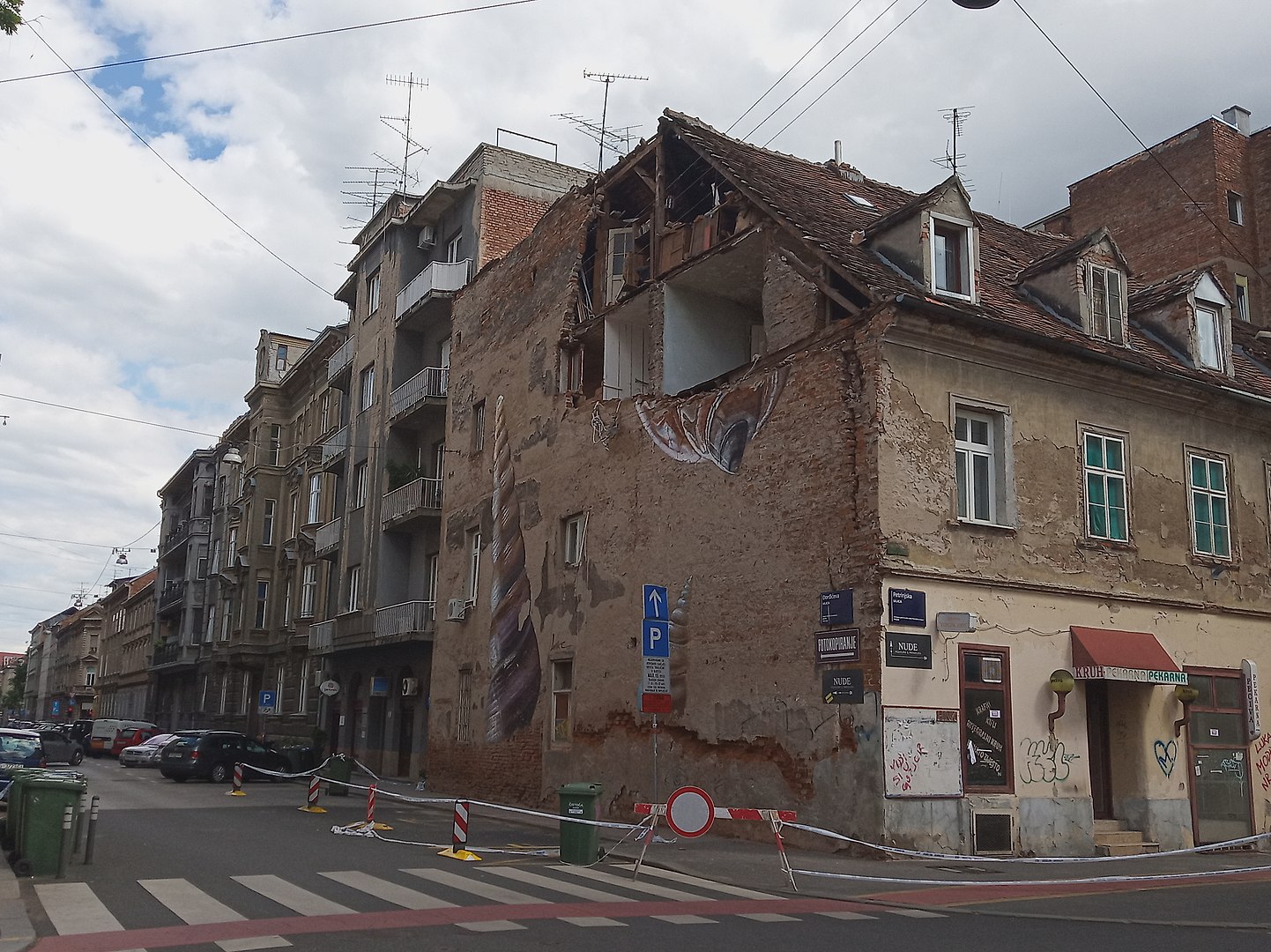 Damage to a Zagreb city-centre building in the 2020 earthquake © Franjo Tahy
Damage to a Zagreb city-centre building in the 2020 earthquake © Franjo Tahy
The tragic news of a fatality filtered through the media several hours later, as did pictures of the devastation visited upon the Croatian capital's buildings. Some of its oldest were hit particularly hard. However, most modern constructions had emerged largely unscathed. Acknowledging the area's seismic capabilities, everything built after the 1963 earthquake of Skopje in neighbouring Macedonia had been constructed to withstand such force.
Offers of help soon began to arrive from overseas. Despite international struggles related to Coronavirus, many still had sympathy upon hearing of the Zagreb earthquake. This outside sympathy and the media that prompted it were rarely directed to the semi-rural communities which experienced the earthquake's fiercest force. The front of the town church in Čučerje, surrounded by scaffolding seven months after the earthquake
The front of the town church in Čučerje, surrounded by scaffolding seven months after the earthquake
The small town of Čučerje is just short of 11 kilometres to the north-east of Zagreb city centre. In late October, the town looks impossibly pretty – houses perched in the foothills of Mount Medvednica, surrounded by greenery and trees exploding in a myriad of autumn shades. But, behind the colourful exterior lies a hidden suffering.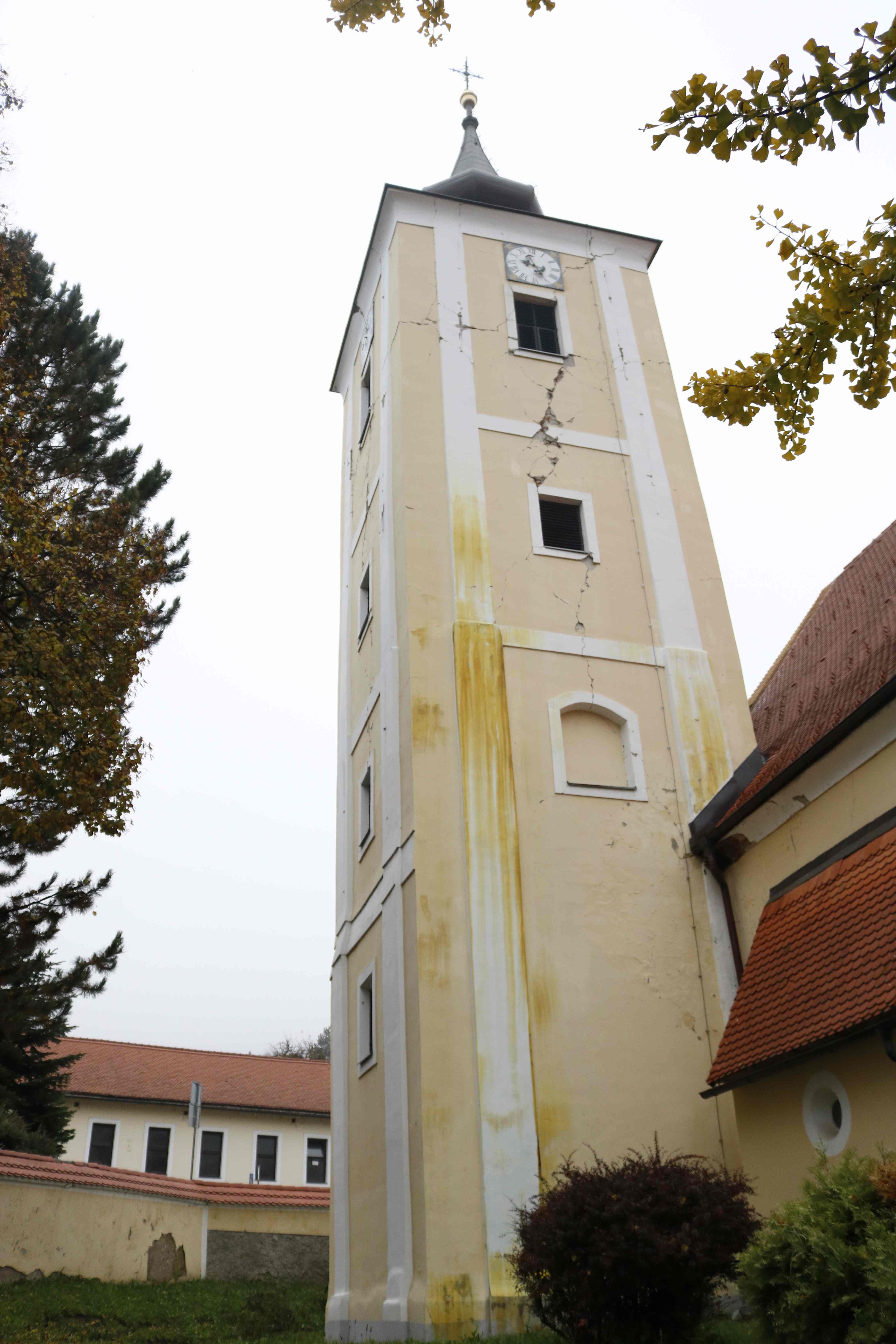 The spire of Čučerje's church is scarred on all sides by long-veined cracks
The spire of Čučerje's church is scarred on all sides by long-veined cracks
Čučerje lies just 500 metres from the epicentre of the earthquake. Scaffolding bolsters the town church, its spire scarred on all sides by long-veined cracks. Back from the main road, down simple, country lanes, sit houses much older than those standng proud above the centre. Here, life still exists in a way similar to that of the original residents of such dwellings. Elderly neighbours are preparing to heat their homes by wood-fired burners, chasing away the chill seeping in through the cracks the earthquake has left. As winter approaches, such hardships are not always reported as loudly as those faced by the damaged cultural institutions holding priceless collections in the capital. But, the struggle does not go unnoticed by Zagreb Volunteers Centre (VCZ).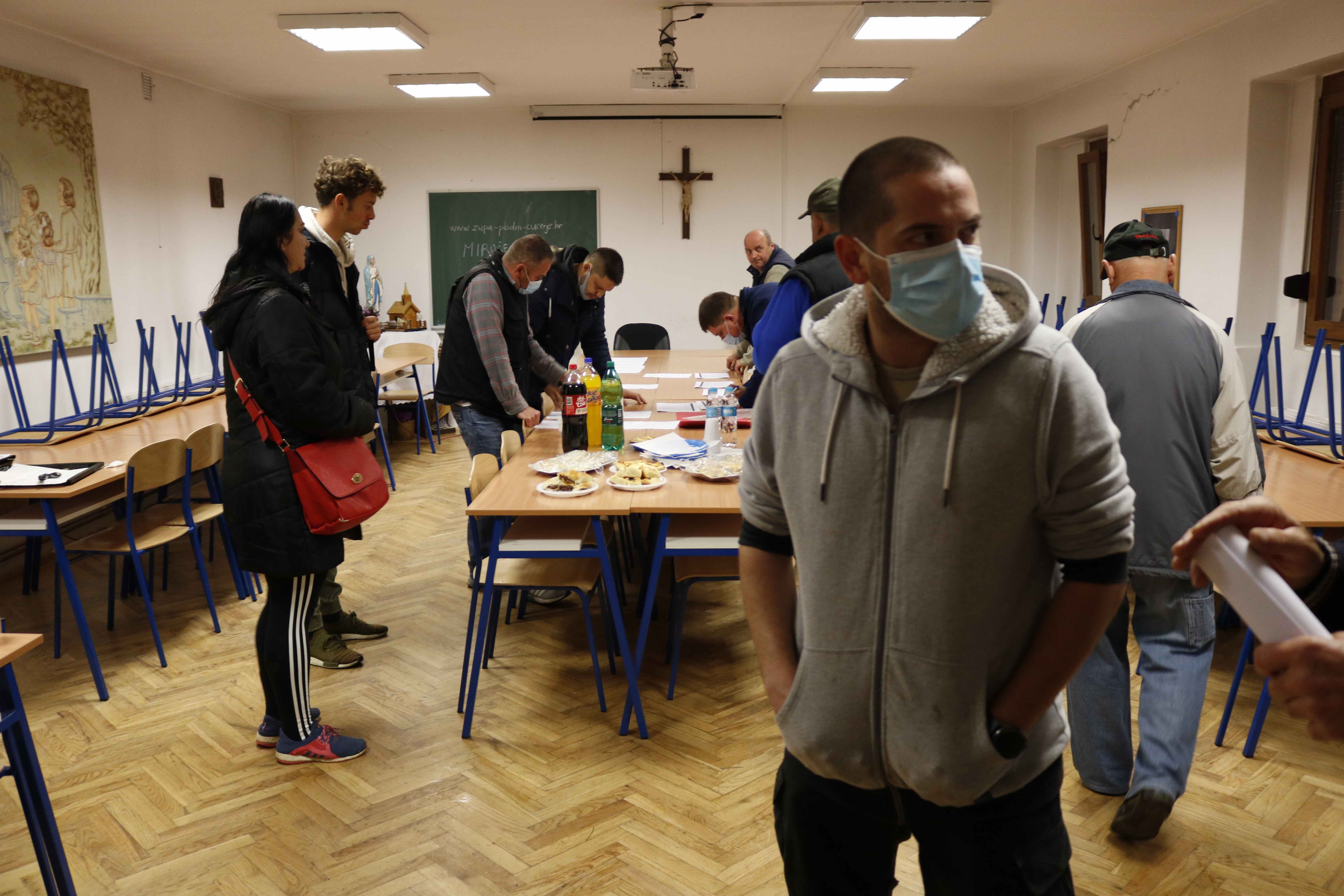 Čučerje residents and members of Zagreb Volunteers Centre meet in the community centre to plan the day's action
Čučerje residents and members of Zagreb Volunteers Centre meet in the community centre to plan the day's action
Established in 1998, Zagreb Volunteers Centre acts as a conduit between charities, communities and non-profit organisations who need support and those willing to donate their time to good causes. Since it was formed, over 18, 000 people have submitted their names to the centre as potential Zagreb volunteers who may be called upon. The centre has helped over 700 organisations find Zagreb volunteers.
“Before 1996, there was a set-up that facilitated international volunteering - it helped connect Croatians with international actions that were looking for help,” says 28-year-old Dunja Hafner, who works for Zagreb Volunteers Centre. “But, it was noticed that some people couldn't commit to an overseas trip and that others simply just preferred only to volunteer locally. The logical step was to move into facilitating that.”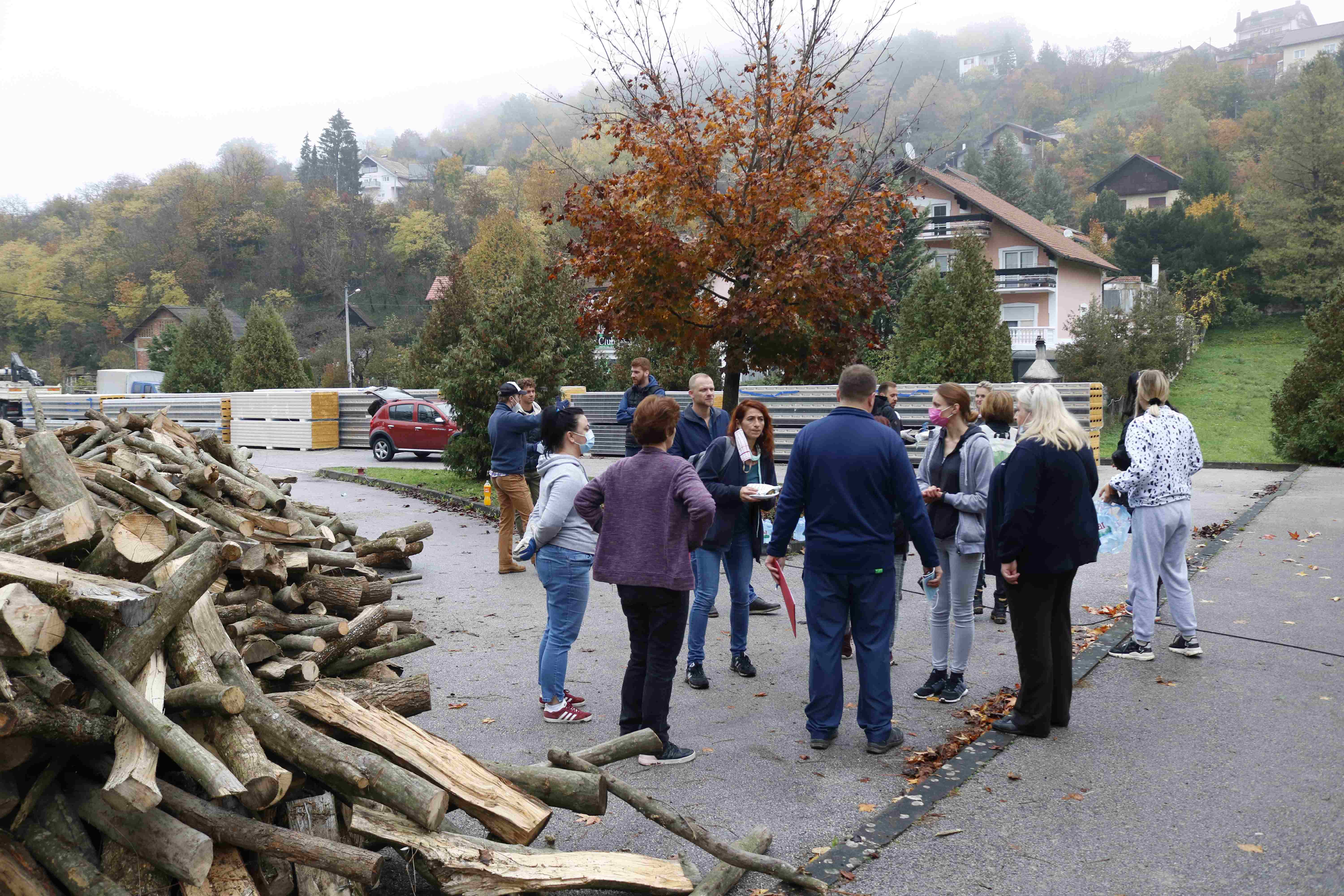 Zagreb volunteers gather in the early morning mist
Zagreb volunteers gather in the early morning mist
“Since we started, the numbers of Zagreb volunteers in our database has grown steadily. But, over more recent times, volunteering does seem to have become a more popular thing to do. And, many people have put their names forward for volunteering since the advent of the earthquake. In the immediate aftermath, there were so many people volunteering that we had to just direct people to the specific groups who were appealing for help. We even had to turn down some Zagreb volunteers who offered their time. That had never previously happened in the history of the organisation. Now, we are managing better and we help co-ordinate some of the actions ourselves.”
“Before the earthquake, the main volunteering areas to which we would send people were actions for children, the elderly, events like culture, sports and music festivals, animals, ecology projects and nature conservation.”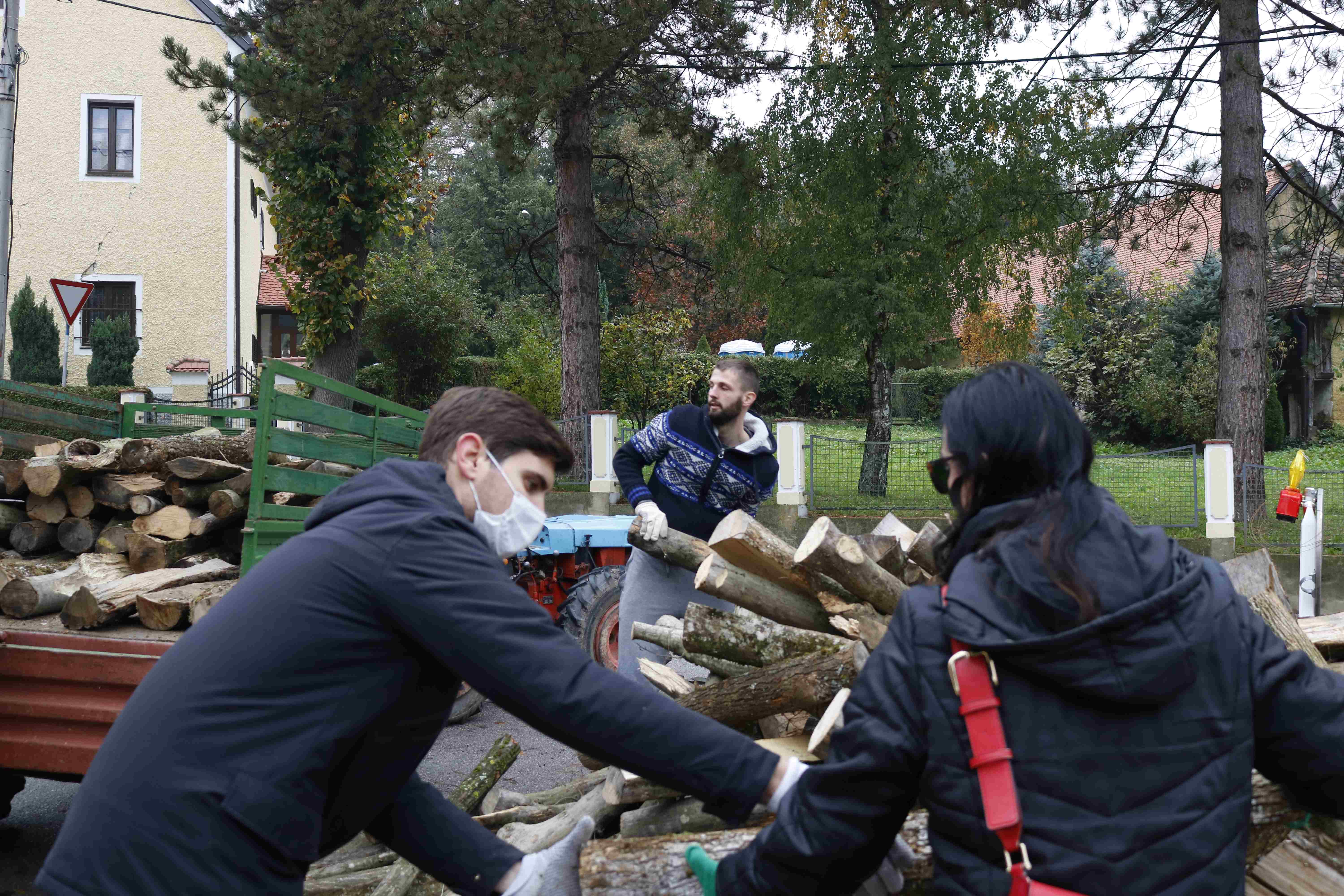 My name is Dražen Blažević (centre), I was born in Croatia. My mother and grandparents are all from Zagreb. This is the city where I live. At the moment, I don't have regular employment, so I can afford to give my time to an action like this. While I'm looking for a full-time job, I make ends meet by doing food deliveries on my bicycle. Why am I here today? Honestly, it was only two weeks ago that I just had this feeling that I should give my time to help people. In one minute I decided I would volunteer. Before this, the kind of help I would give was only to my neighbours, the elderly relatives of friends. People like that. As an official volunteer, this is my first time. Maybe this sounds a little selfish, but I thought it would make me feel good.
My name is Dražen Blažević (centre), I was born in Croatia. My mother and grandparents are all from Zagreb. This is the city where I live. At the moment, I don't have regular employment, so I can afford to give my time to an action like this. While I'm looking for a full-time job, I make ends meet by doing food deliveries on my bicycle. Why am I here today? Honestly, it was only two weeks ago that I just had this feeling that I should give my time to help people. In one minute I decided I would volunteer. Before this, the kind of help I would give was only to my neighbours, the elderly relatives of friends. People like that. As an official volunteer, this is my first time. Maybe this sounds a little selfish, but I thought it would make me feel good.
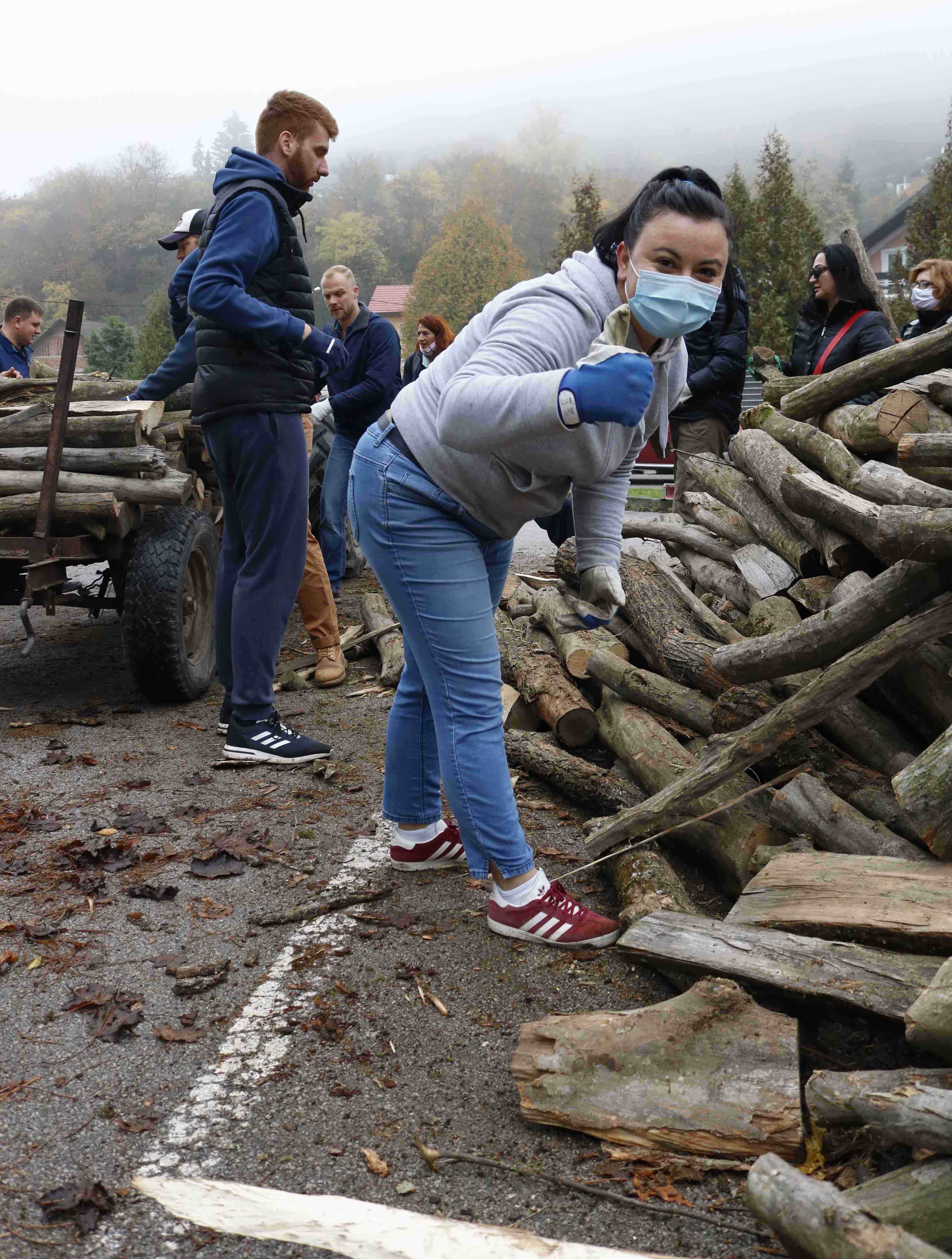 My name is Alexandra and I am from Čučerje. I live here with my family. Right now, I am without a full-time job, so I take on some other daily obligations – I accompany kids to kindergarten and school, and I help out in our local church. I look after their social media pages for them. I also play the organ in the church. It was a very simple decision for me to join in with today's action – I live here. I walk past the devastation left by the earthquake every day. This town has experienced lots of problems because of the damage. For me, giving my time today is a way of showing the love I have for my town and the people who live here. Well, something like that.
My name is Alexandra and I am from Čučerje. I live here with my family. Right now, I am without a full-time job, so I take on some other daily obligations – I accompany kids to kindergarten and school, and I help out in our local church. I look after their social media pages for them. I also play the organ in the church. It was a very simple decision for me to join in with today's action – I live here. I walk past the devastation left by the earthquake every day. This town has experienced lots of problems because of the damage. For me, giving my time today is a way of showing the love I have for my town and the people who live here. Well, something like that.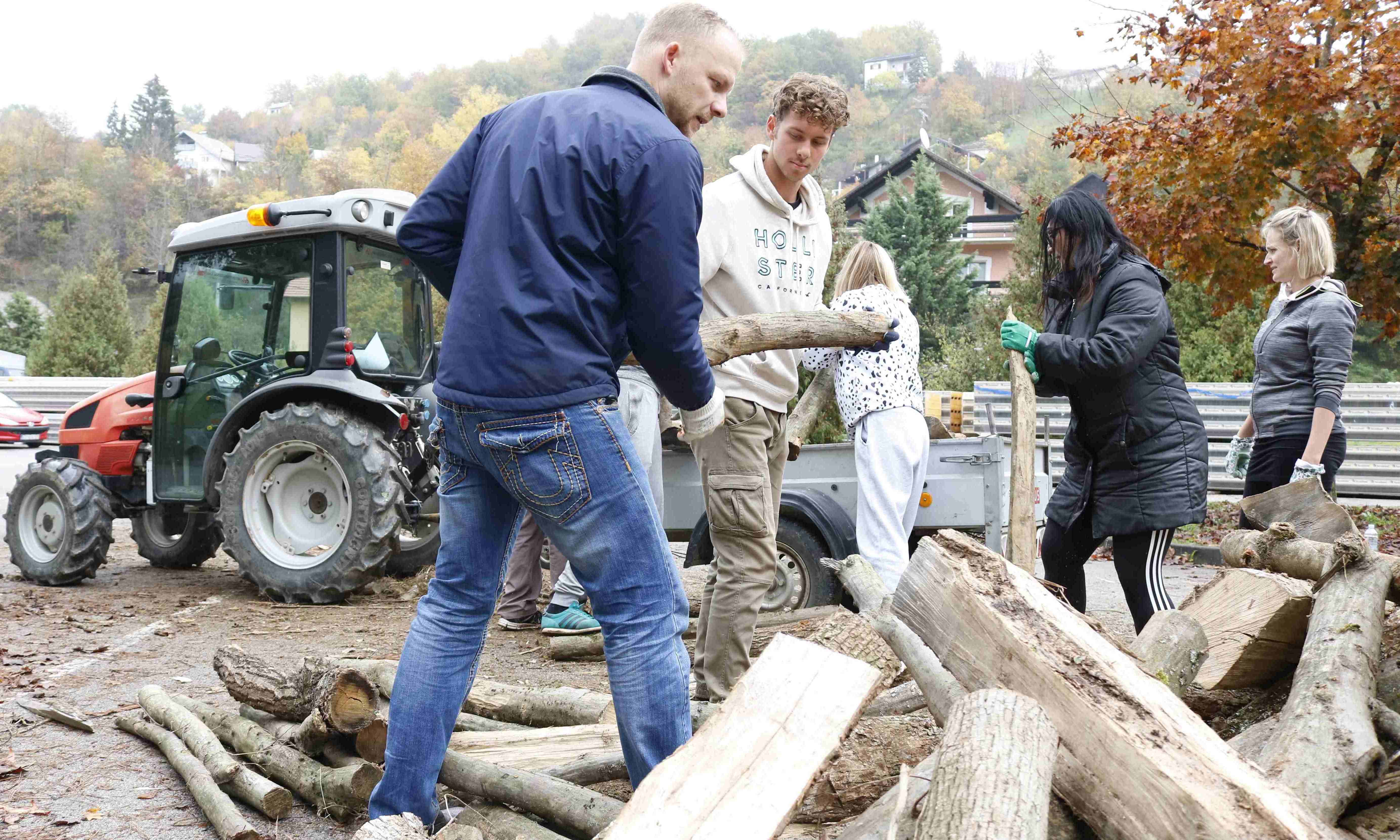
 My name is Borut Babanić (right) and I'm from Zagreb. I work as a project manager. I wanted to volunteer so I could help people. The residents of Čučerje are some of the worst affected by the earthquake and so that's why I want to come here specifically. I wanted them to not feel that they are alone. This is the first time I joined an action via the Zagreb Volunteer Centre.
My name is Borut Babanić (right) and I'm from Zagreb. I work as a project manager. I wanted to volunteer so I could help people. The residents of Čučerje are some of the worst affected by the earthquake and so that's why I want to come here specifically. I wanted them to not feel that they are alone. This is the first time I joined an action via the Zagreb Volunteer Centre.
My name is Antonio Frinčić (left). I'm from Zagreb. I work for the Croatian Foundation For Children. It's an organisation that assists in looking after children and families who have small incomes or limited means. It's a state-funded organisation. My position there is a paid one. This is not the first voluntary work I've undertaken, but it is the first time I have volunteered through the Zagreb Volunteer Centre. My answer is the same as Borut's – I came here because I wanted to help these people.
Borut and Antonio are pictured side-by-side because they spent most of the day working together. When they arrived in the morning, they were strangers. They left as friends.
 My name is Marina Krolo and I'm originally from Split. I studied in Zagreb, finished university here and then stayed. My regular role in society is that I'm a tour guide and tour leader. That pretty much means that this is my year off, ha! There's not much work for a tour guide in 2020, so I'm trying to put my free time to good use. This is the first time I've volunteered through Zagreb Volunteer Centre.
My name is Marina Krolo and I'm originally from Split. I studied in Zagreb, finished university here and then stayed. My regular role in society is that I'm a tour guide and tour leader. That pretty much means that this is my year off, ha! There's not much work for a tour guide in 2020, so I'm trying to put my free time to good use. This is the first time I've volunteered through Zagreb Volunteer Centre.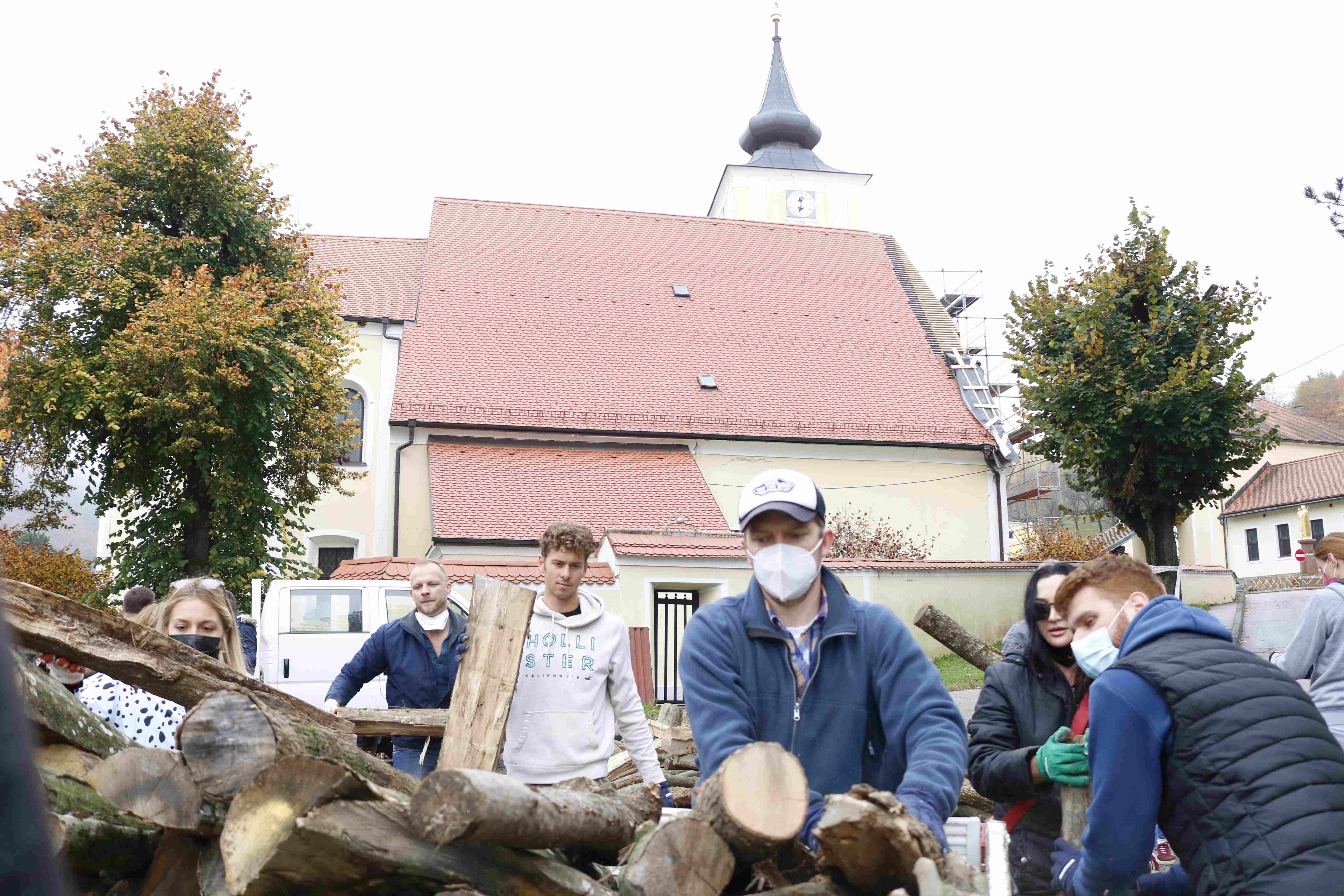
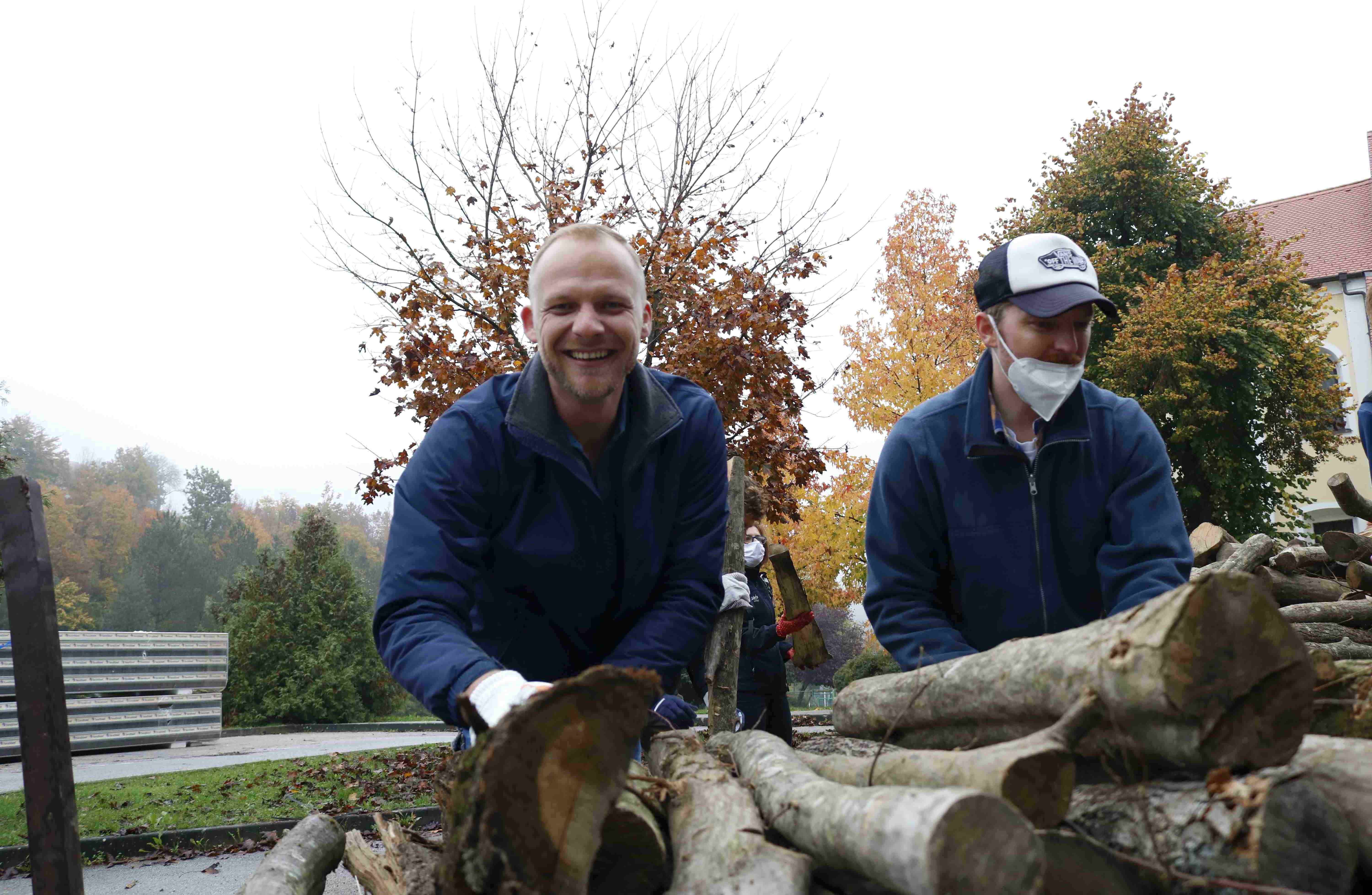 My name is Vincent Matijaca. I was born in Split. I'm based in Zagreb now. We opened a company BioCro LTD in the United Kingdom a few months ago. What we're trying to do is assist small producers and OPGs from this region to place their products internationally, including the UK and other countries in Europe. Why am I here today? Well, we believe that you can't start promoting sustainability and help solely from the office, we believe our project to be more hands-on. By doing that we hope to be able to show what we're about, and to set an example that perhaps others will follow. We've previously joined actions through other Croatian volunteer organisations and others internationally, but this is the first time we've done so through Zagreb Volunteer Centre.
My name is Vincent Matijaca. I was born in Split. I'm based in Zagreb now. We opened a company BioCro LTD in the United Kingdom a few months ago. What we're trying to do is assist small producers and OPGs from this region to place their products internationally, including the UK and other countries in Europe. Why am I here today? Well, we believe that you can't start promoting sustainability and help solely from the office, we believe our project to be more hands-on. By doing that we hope to be able to show what we're about, and to set an example that perhaps others will follow. We've previously joined actions through other Croatian volunteer organisations and others internationally, but this is the first time we've done so through Zagreb Volunteer Centre. Local people from Čučerje and the surroundings had prepared food to make sure the volunteers didn't go hungry. This dish was made and donated by a local hairdresser. It is a local speciality called tenka gibanica. It was delicious.
Local people from Čučerje and the surroundings had prepared food to make sure the volunteers didn't go hungry. This dish was made and donated by a local hairdresser. It is a local speciality called tenka gibanica. It was delicious.
 My name is Tomislav Vlajčić and I'm from Zagreb. At the moment, my regular time is spent studying economy and training football. I'm the team leader of a faculty-related group Tourism Lab that's interested in that area of our economy. This is my first time volunteering. I decided to come because it's a good opportunity to help people who are in need and I'm really glad I came. The experience was really worth it and meeting new people, seeing a slightly different culture is priceless. I would recommend it to anyone because it all starts with us.
My name is Tomislav Vlajčić and I'm from Zagreb. At the moment, my regular time is spent studying economy and training football. I'm the team leader of a faculty-related group Tourism Lab that's interested in that area of our economy. This is my first time volunteering. I decided to come because it's a good opportunity to help people who are in need and I'm really glad I came. The experience was really worth it and meeting new people, seeing a slightly different culture is priceless. I would recommend it to anyone because it all starts with us.
For the latest travel info, bookmark our main travel info article, which is updated daily.
Read the Croatian Travel Update in your language - now available in 24 languages.
Incredible 18th-Century Castle Oroslavje Donji nr Zagreb On Sale
October 8, 2020 – A bonafide 18th-century Baroque castle is up for sale. Although in a state of neglect, Oroslavje Donji is an architectural gem with huge grounds and lies less than 30 minutes from Zagreb. Its price tag? A cool 1 million Euros.
Zagorje refers to a place behind the mountains. Dalmatinska zagora is the hinterland behind the Dinaric Alps. Hrvatsko Zagorje, often referred to simply as Zagorje is the region behind Medvednica mountain. Dominating the skyline of Zagreb, Medvednica lies just north of the Croatian capital and is much loved for recreation, enjoying nature and feasting on traditional foods. In winter, the far side of the mountain offers skiing and when your skis reach the bottom of the slopes, you're at the entrance to Zagorje. Although, Zagorje has another entrance.
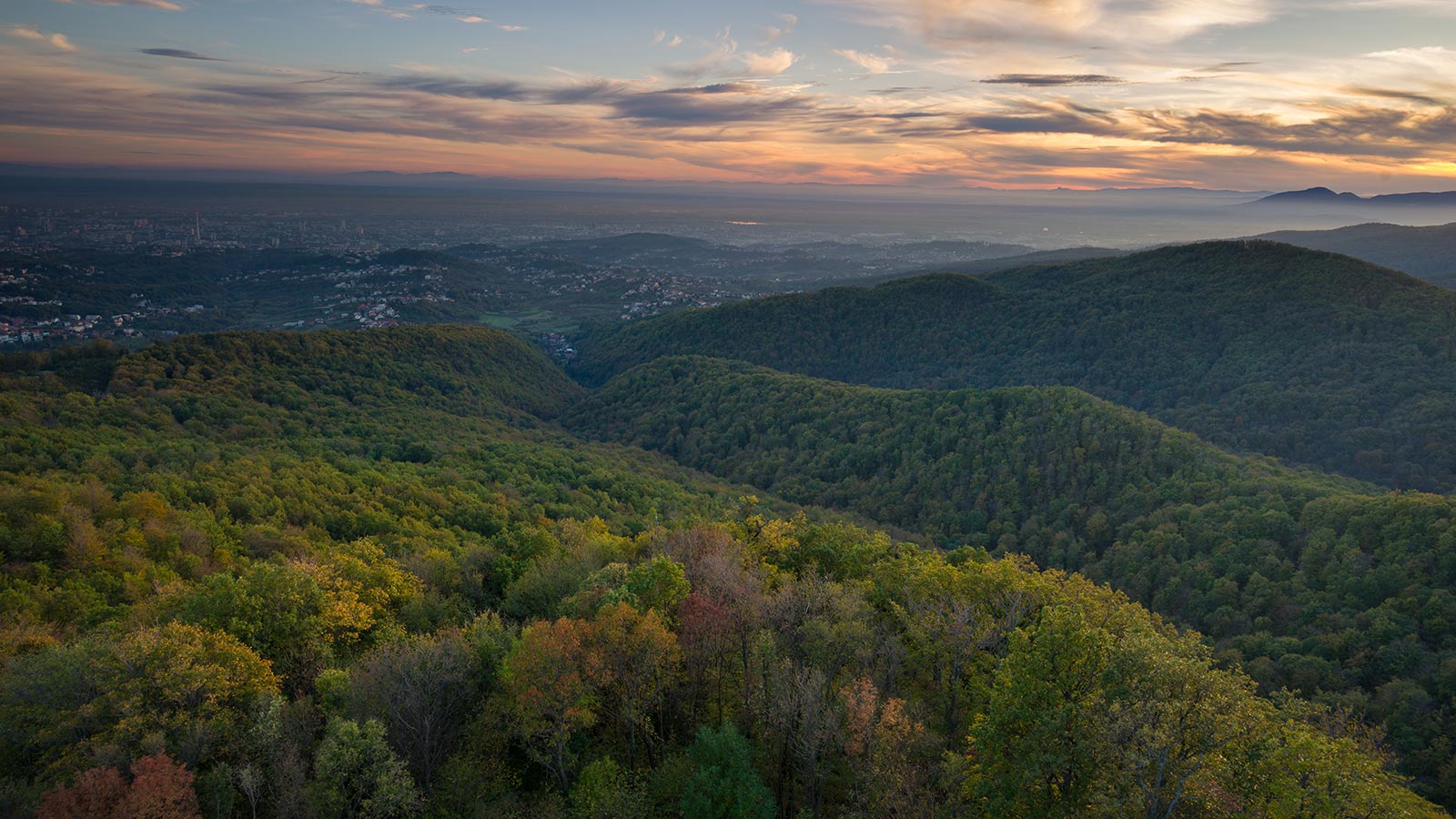 The Medvednica mountain overlooks Zagreb. On the other side lies Zagorje © Antun Cerovečki / Croatian National Tourist Board
The Medvednica mountain overlooks Zagreb. On the other side lies Zagorje © Antun Cerovečki / Croatian National Tourist Board
Oroslavje: The Gate of Croatian Zagorje (Vrata Hrvatskog zagorja)
The pretty town of Oroslavje is sometimes called The Gate of Croatian Zagorje (Vrata Hrvatskog zagorja). Though it lies less than 30 minutes drive from Zagreb, Oroslavje feels far from the bustle and pace of the metropolis. It's the kind of idyllic bolthole that Londoners dream of having half an hour from the English capital, a place where premium properties would be snapped up in an instant by the rich and famous. Such places and properties are rarely attainable in such close proximity to London. But, they are in Zagreb.
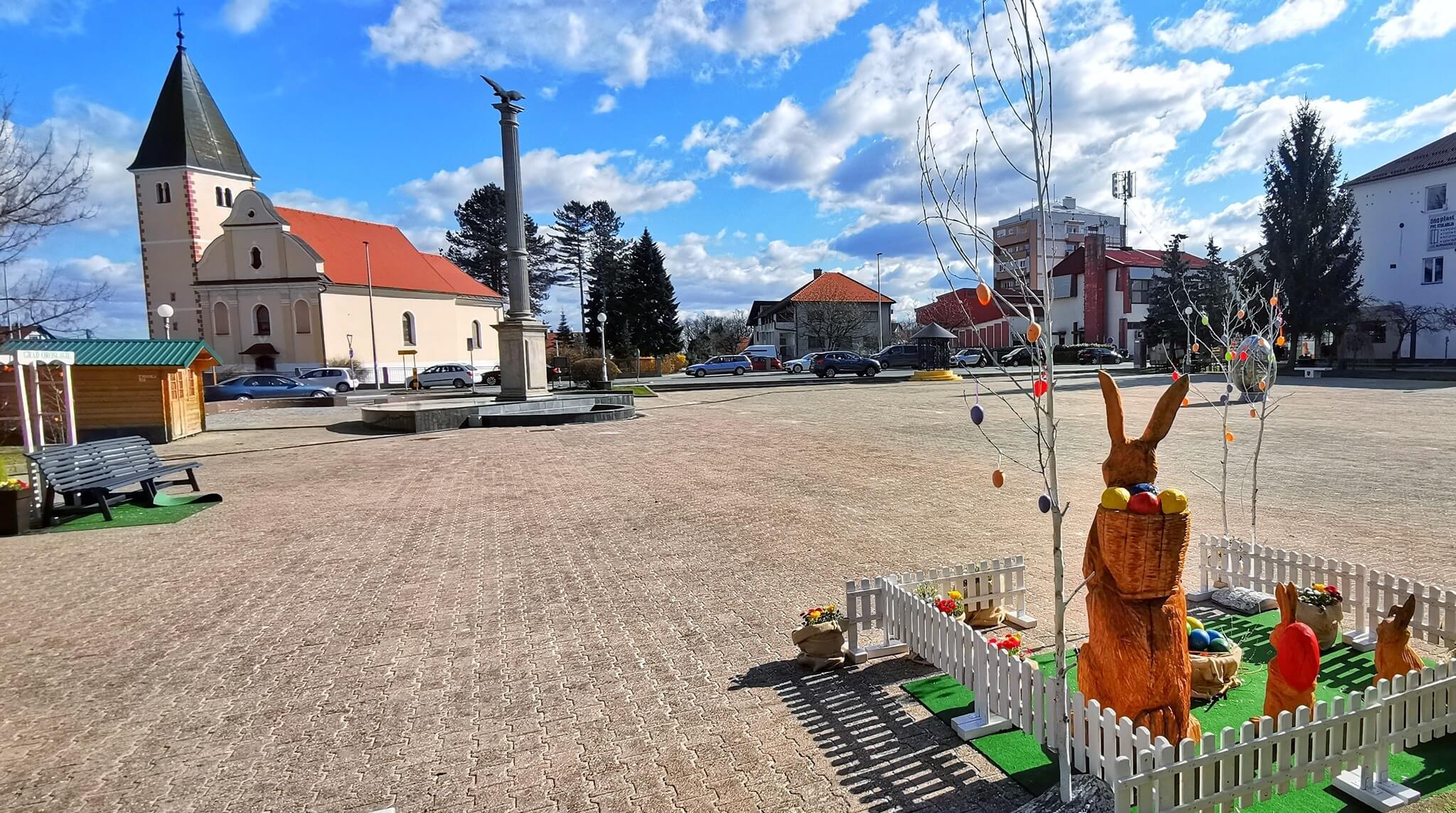 Oroslavje © Grad Oroslavje
Oroslavje © Grad Oroslavje
A bonafide 18th-century castle in Oroslavje has gone up for sale. Oroslavje Donji is a Baroque castle of 1,270 m2 with four wings, an inner courtyard and a park-sized garden that extends an incredible 26,235 m2. Although in a serious state of disrepair, it is an incredibly grand and historic building. The price tag is a cool 1 million Euros.
Opportunities to buy such dwellings do not come around so often. And, in a charming feature on the sale by zagreb.info, co-owners of the building are said to be hesitant about letting it go. Stunning pictures and details make that more than understandable.
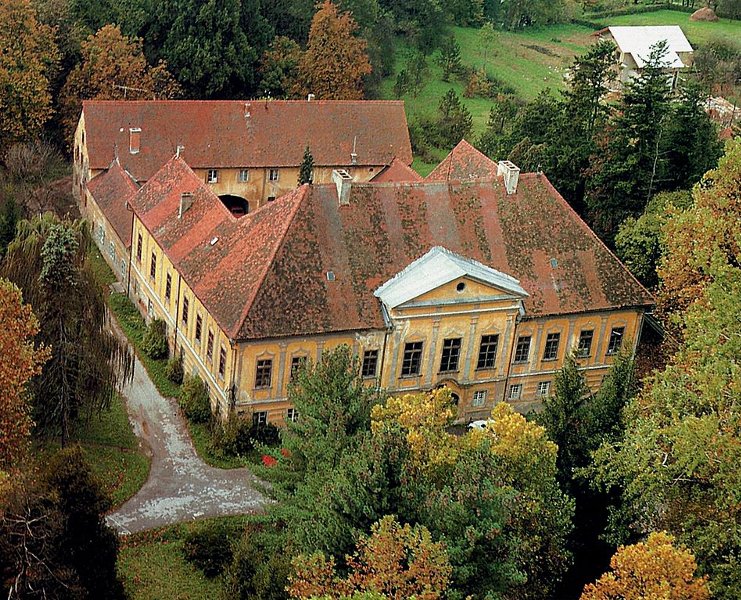 Oroslavje Donji © Njuskalo
Oroslavje Donji © Njuskalo
The first-floor vault of Oroslavje Donji's main hall holds beautiful wall paintings created in the late 18th century. Elsewhere, 19th-century wall paintings can be found, thankfully above the height of the spray paint graffiti left by some unauthorised visitors - the castle has been left abandoned for many years.
 © Turistička zajednica grada Oroslavja
© Turistička zajednica grada Oroslavja
However, most of the building's major architectural details remain intact, as do ornate, original floor tilings. Outside, at the entrance to the park, there is a magnificent baroque portal. Two Baroque statues also lie within the garden which, in line with trends of the time, was furnished in the late 19th century with exotic trees from all over the world. Today, many species of birds make their home within the branches, undisturbed by human presence.
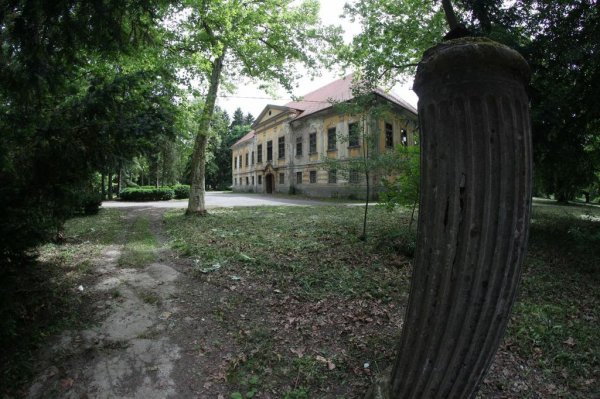 © Turistička zajednica grada Oroslavja
© Turistička zajednica grada Oroslavja
Well connected to Zagreb, Slovenia and Hungary, Oroslavje and other nearby towns were once favoured places to live by the upper echelons of Austro-Hungarian society. Oroslavje used to have two castles, but Gornje Oroslavje was almost completely destroyed by a fire in 1949. Oroslavje Donji was home to the Vojkffy family (Vojković in Croatian).
In a former life: The Vojkffy / Vojković family in Oroslavje Donji
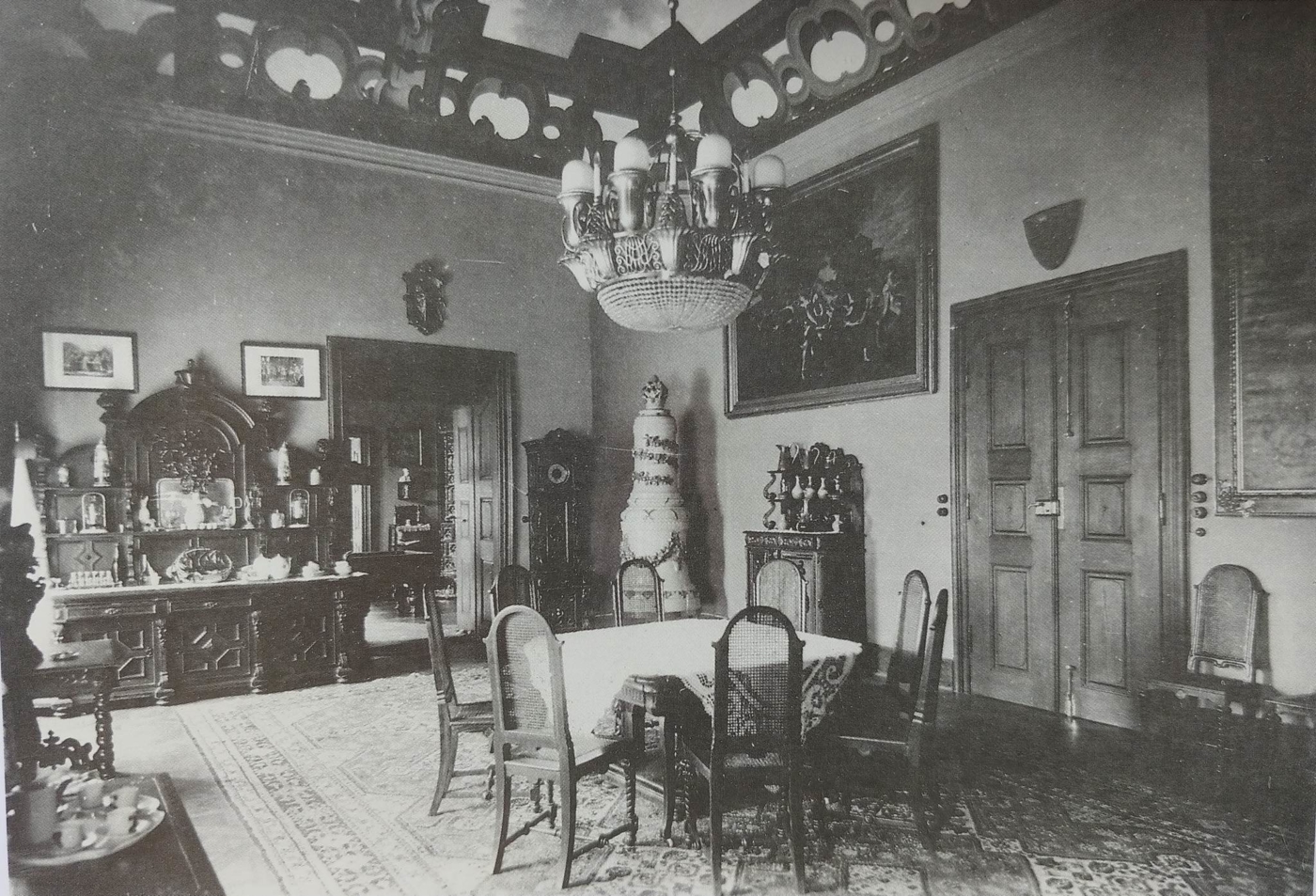 The inside of Oroslavje Donje when still inhabited © Faculty of Architecture University of Zagreb
The inside of Oroslavje Donje when still inhabited © Faculty of Architecture University of Zagreb
The family earned titles and lands for their service to the Austro-Hungarian empire in their struggle against the invading Ottomans. Ivan Vojkffy I (1520–1595) was the captain of the town of Karlovac, and his son Ivan Vojkffy II (1595–1661) captain of the town of Križevci. In the 17th century, the family moved to Hrvatsko Zagorje.
Sigismund Vojkffy was the royal chamberlain and commander of the guards at Schönbrunn Palace in Vienna during the reign of Empress Maria Theresa. For service in the Seven Years' War (1756–63), Maria Theresa awarded both Sigismund and his brother Christopher the title of count in 1763.
 Janko Vojković, son of Sigismund. He lived at Oroslavje Donje © Silverije
Janko Vojković, son of Sigismund. He lived at Oroslavje Donje © Silverije
These were high decorations in the court of the empire. The family subsequently went on to build not only Oroslavje Donje (1770–90) but also the parish church of St. Jelena in Zabok (1782–1805) and several palaces in Zagreb's Upper Town, the most famous of which is the Baroque Vojković-Oršić-Rauch Palace in Matoševa Street. Sigismund Vojkffy died only two years after Oroslavje Donje was completed, but his descendants, including his son Janko, continued to live there.
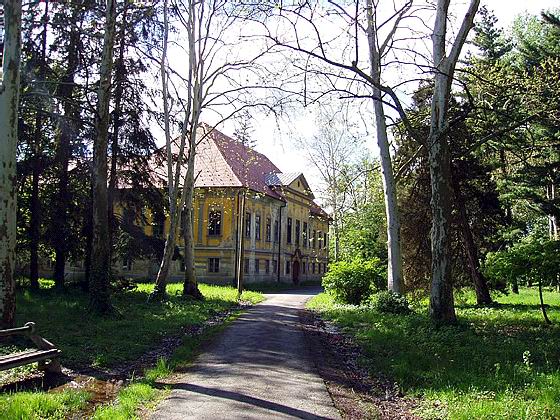 © Turistička zajednica grada Oroslavja
© Turistička zajednica grada Oroslavja
In its golden age, Oroslavje Donje held an approach that was 230 meters in length. In front of the south façade was a decorative garden, to the south-west the park was connected to the forest, and to the left of the approach was a spacious meadow. The last male descendants of the Vojkffy family, Sigismund's grandsons, emigrated from Croatia in the late 19th century. Thereafter, Oroslavje Donje changed hands a number of times before being confiscated by the state in the era of Yugoslavia and subsequently fell into disrepair.
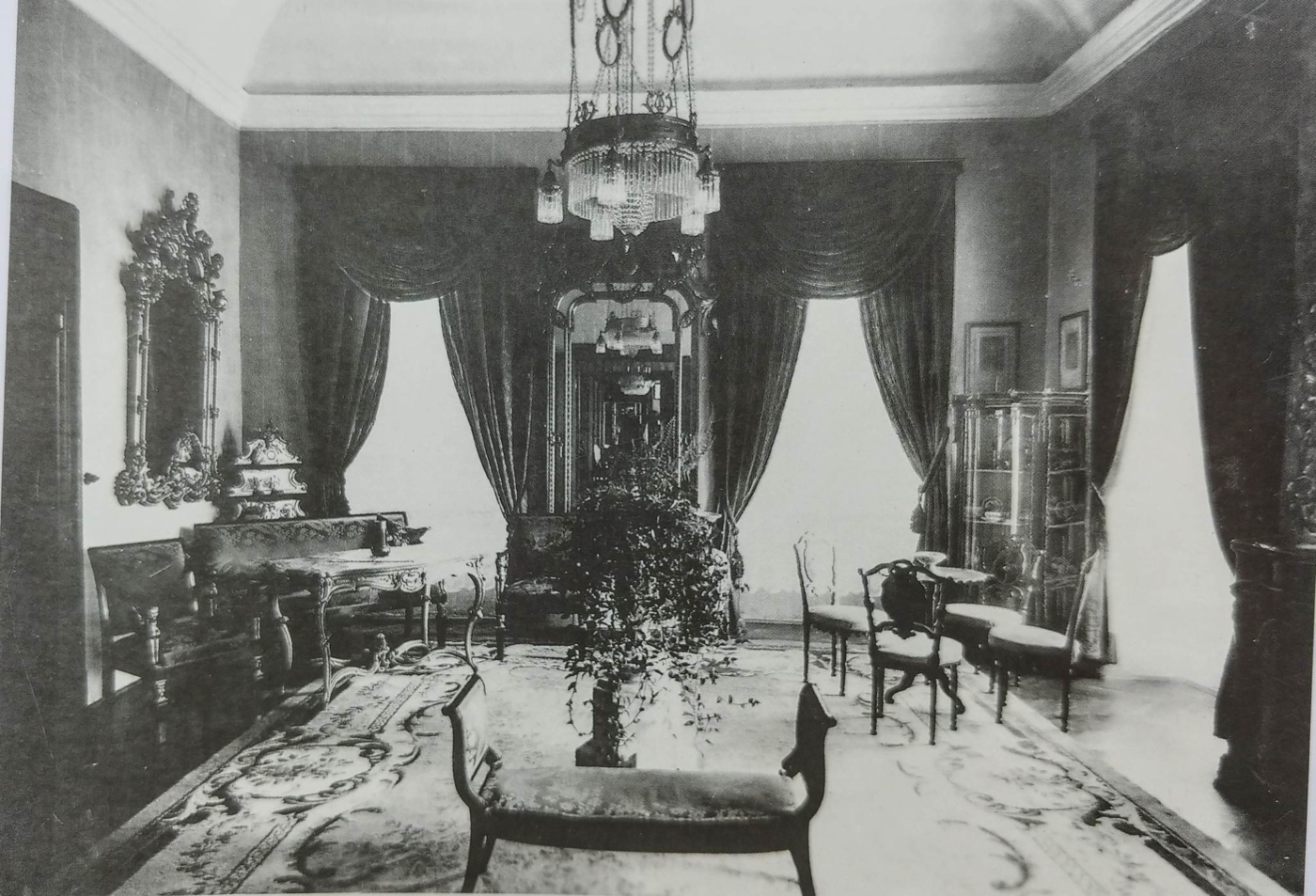 How the interior of Oroslavje Donje looked in its heyday © Faculty of Architecture University of Zagreb
How the interior of Oroslavje Donje looked in its heyday © Faculty of Architecture University of Zagreb
Though few properties like this appear on the market, there are surely a limited number of people who could afford the price tag. Even fewer who would have the funds and determination to restore Oroslavje Donje to its original state of grandeur. But, who knows? A buyer might appear. After all, who wouldn't want to live in a beautiful Baroque castle just 30 minutes from Zagreb?
If you want to read more about some of Croatia's best castles, then look here.
For the latest travel info, bookmark our main travel info article, which is updated daily.
Read the Croatian Travel Update in your language - now available in 24 languages.
Gondolas Able to Accommodate 10 People Arrive at Sljeme Cable Car
Sljeme is a favourite destination for many of Zagreb's residents. From skiing in the winter months to hiking and enjoying the views in the dense forests just above the Croatian capital in the summer months, what you can do on Zagreb's famous hill varies with the changing of the seasons. The Sljeme cable car, a project that was in the works for a very long time indeed, is yet another addition.
As Poslovni Dnevnik writes on the 17th of July, 2020, there will be about eighty gondolas placed at the Sljeme cable car, they will move six metres per second and will be able to carry 1,500 passengers in just one hour. The very first cabins of the Sljeme cable car, mounted on steel cables with which they will slide along, were installed over recent days.
One was photographed at the very top of Medvednica, which is the first time that a gondola has (almost) reached the height of the TV tower itself, given that the new Sljeme cable car route is one hundred metres longer than the old one was. One cabin is ready at the lower station, and the first test rides are along the route, as has been found out unofficially from the construction site, will begin at the end of August.
The opening of the Sljeme cable car itself is planned for All Saints' Day, according to a report from Vecernji list.
The new cabins, on the other hand, are 2.1 metres tall and two metres wide, they will accommodate a maximum of ten passengers at a time who will be able to sit on two folding benches. They will also be adapted for people in wheelchairs, and they will be able to accommodate stretchers for the injured.
Skiers and the like will be able store their equipment in special carriers, but there will be no such facilities for transporting bicycles, which will therefore be able to be transported in the gondola itself. The cabins were delivered by an Austrian company specialising in the construction of the Doppelmayr cable car, where all the equipment comes from. They arrived late, as the borders were closed due to the coronavirus pandemic.
For more on the Sljeme cable car and other things to do in the Croatian capital, follow Total Zagreb or check out Zagreb in a Page.
Zagreb Aerial Tram to Sljeme Complete by June: Project Update
After 13 long years, Zagreb will finally get its aerial tram. Here's what the ride will look like. And, like it or not, we’ll have it for the next 50 years. Zagreb residents will soon be able to take the aerial tram to Sljeme again. And four months before it opens, RTL has a preview of the ride.
The Sljeme aerial tram (cable car) is almost beginning to resemble the plans for the massive project, according to Petra Mlačić/RTL Direkt on January 23, 2020. Over 11 months ago, before the first shovel broke ground, and even before that first shovel, the gondola came with a 375 million HRK (50.4 million EUR) price tag. In December 2019, ZET secured a loan for 537 million HRK (72.2 million EUR) to complete the costly endeavor. So, Zagreb will finally have an aerial tram, and it will be like no other in Europe!

Massive Zagreb Base Station Will House Offices and Parking
The massive building will be the base station, which will have a stylish glass exterior, and will be surrounded by a beautifully landscaped lawn. It will also feature a bear statue and parking for bicycles. The entire project began at the base station and that is why most of it has been completed.
There will be 80 gondolas running each day, and the entire turntable is already set up. In the evening, when the aerial tram ceases operation, everything will go to into the garage.
The gondola garage is located on the ground floor and offices will be housed on the second floor. There are also two underground floors for parking spaces. The 280 parking spaces will be available to the public after March 1.
The steel poles have been installed by the Brestovac intermediate station, the terrain protected, and track installations finished. The poles, which secure the gondolas, are from six to 38 meters high. UPDATE: See an aerial video of the project below, which was released by the City of Zagreb on January 23, 2020.
Brestovac Station Source of Controversy
The Brestovac intermediate station has caused the most public controversy. There has been talk for months about whether this station was necessary or if someone had an interest in the property. A large part of the land around Brestovac belongs to the Srebrnjak Children's Hospital, so it had to handed over to the City of Zagreb to allow that station to be built.
The Brestovac station will be much smaller than initially planned but will still function as an entry/exit station. After Brestovac, the aerial tram continues for another 800 meters to the top. The final station is currently the furthest from completion, but it was also the last to begin construction. Nevertheless, they say it will be ready by the deadline, which is May 31.
Follow our Lifestyle page to keep updated on ambitious construction projects in Croatia.


